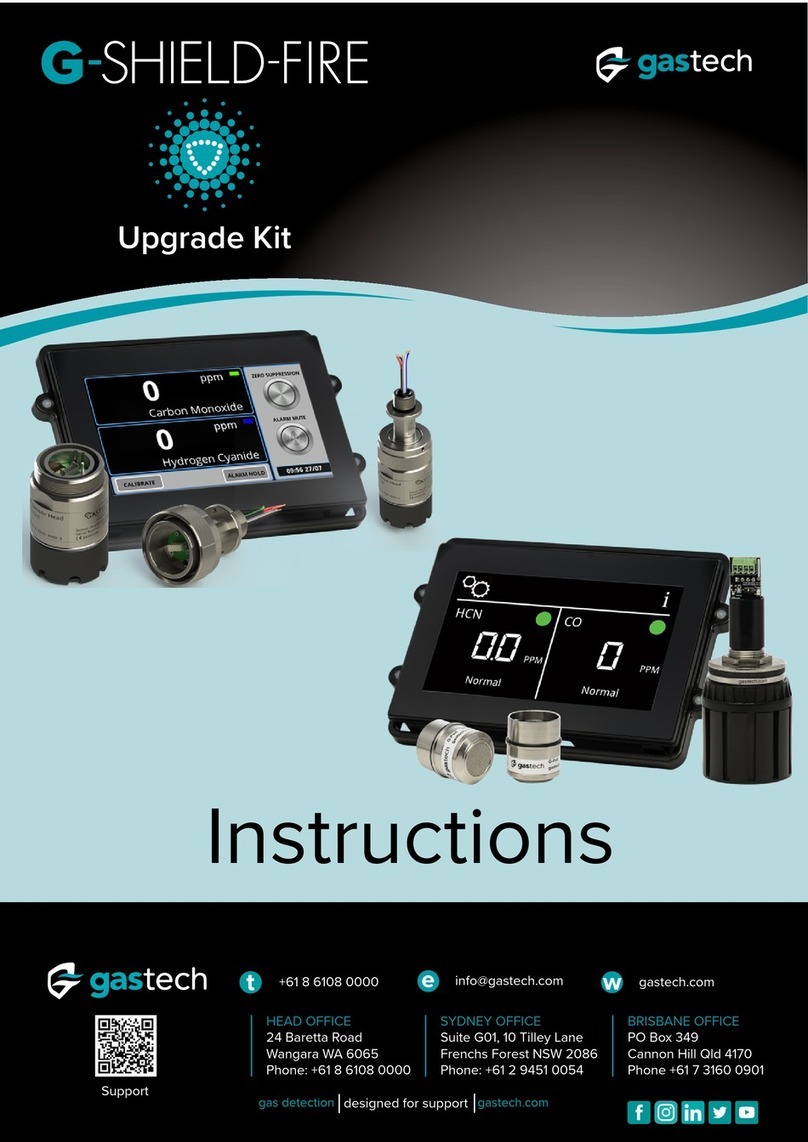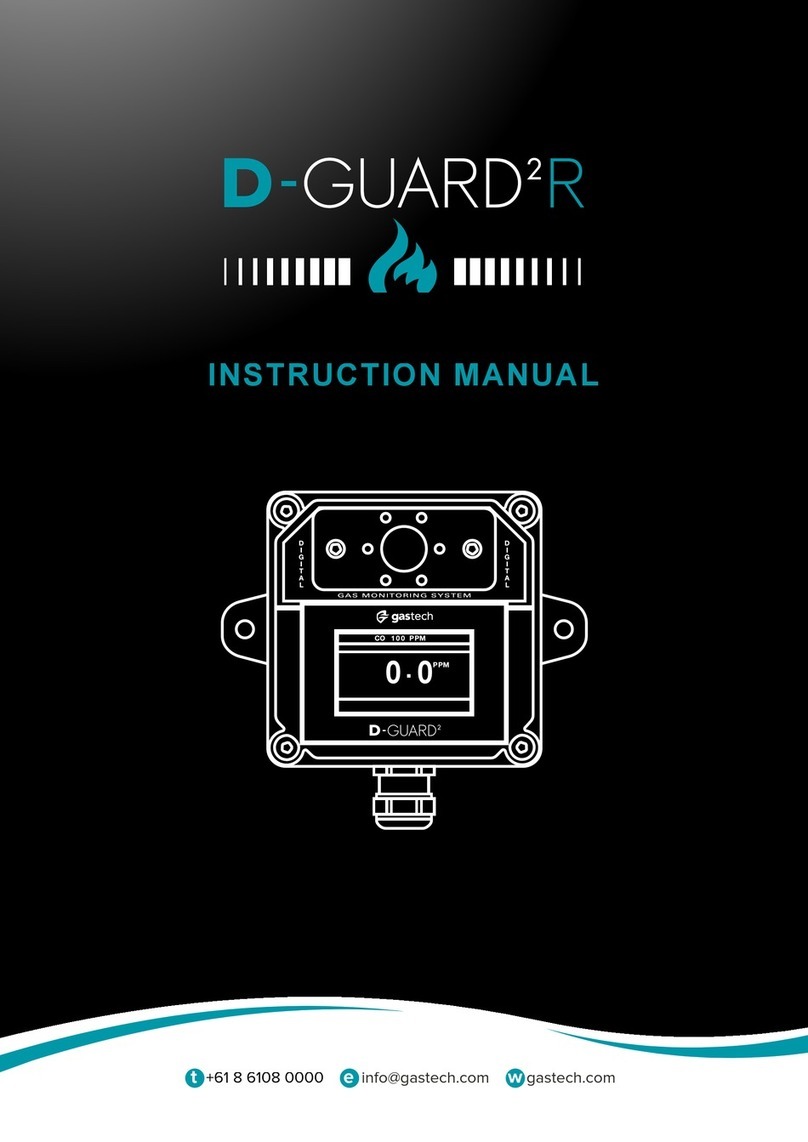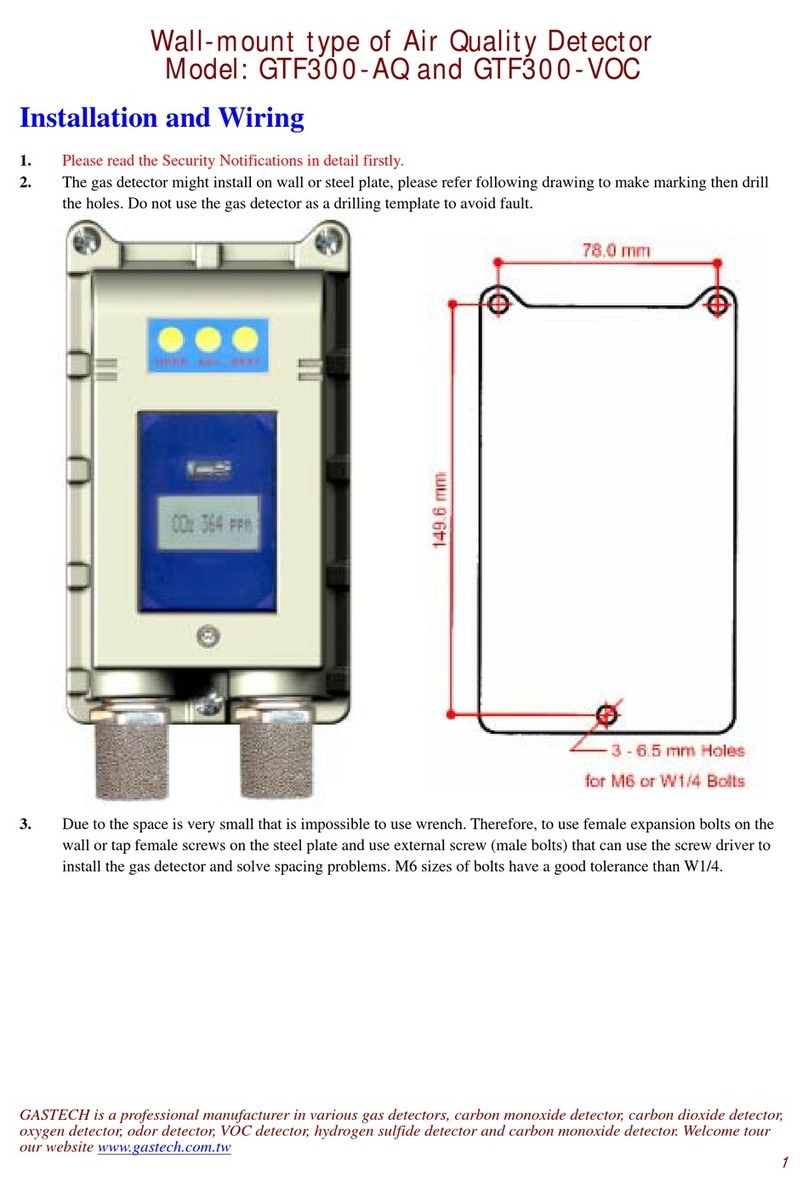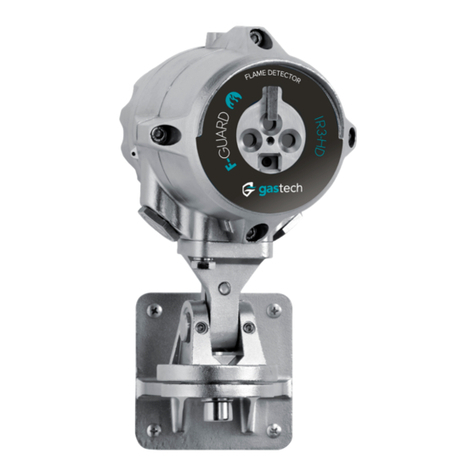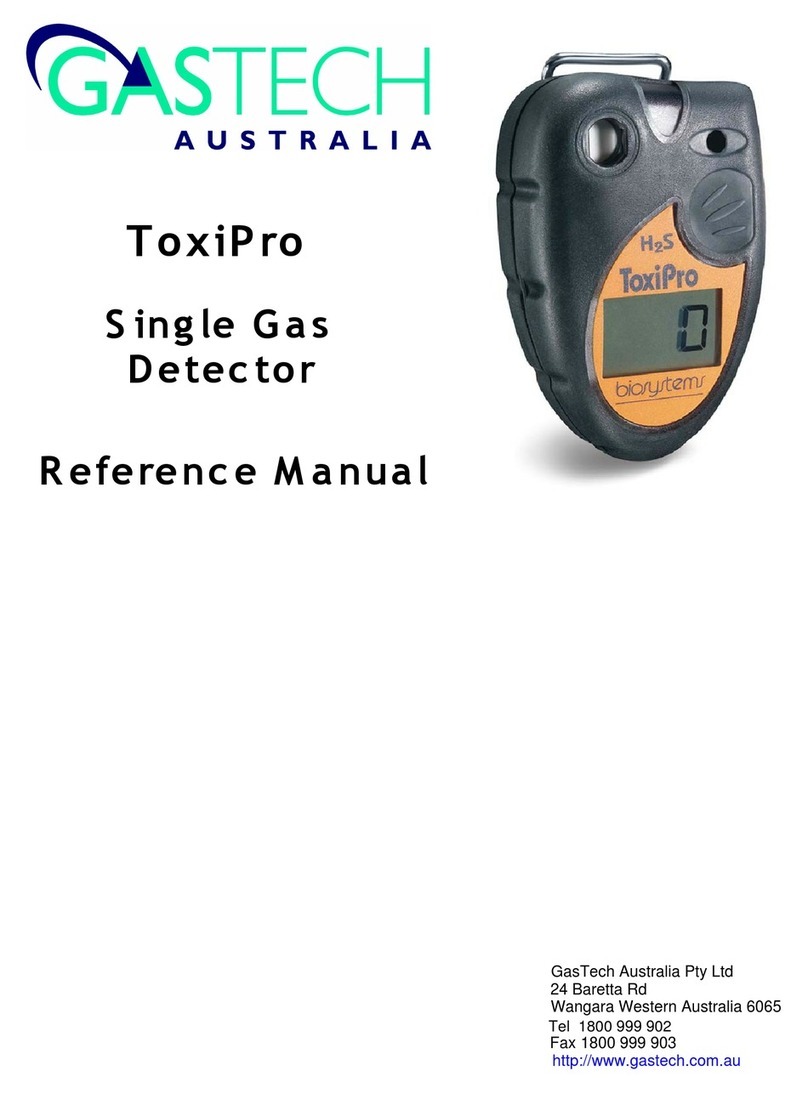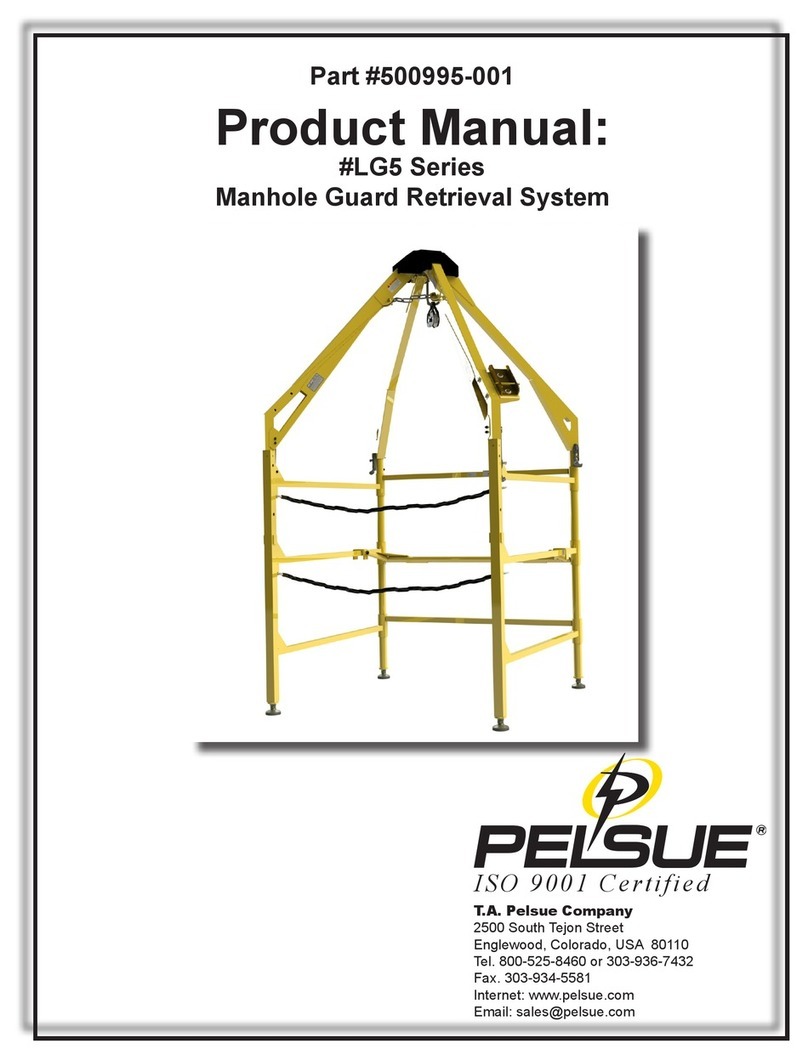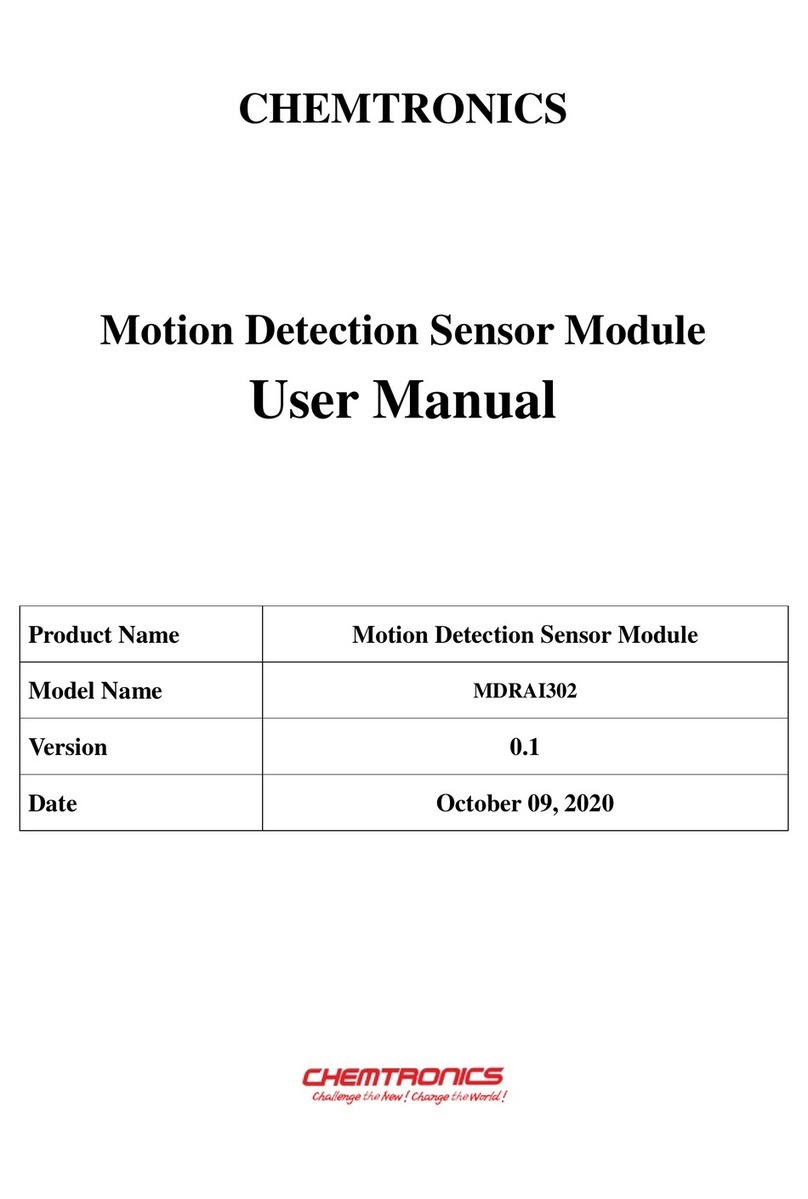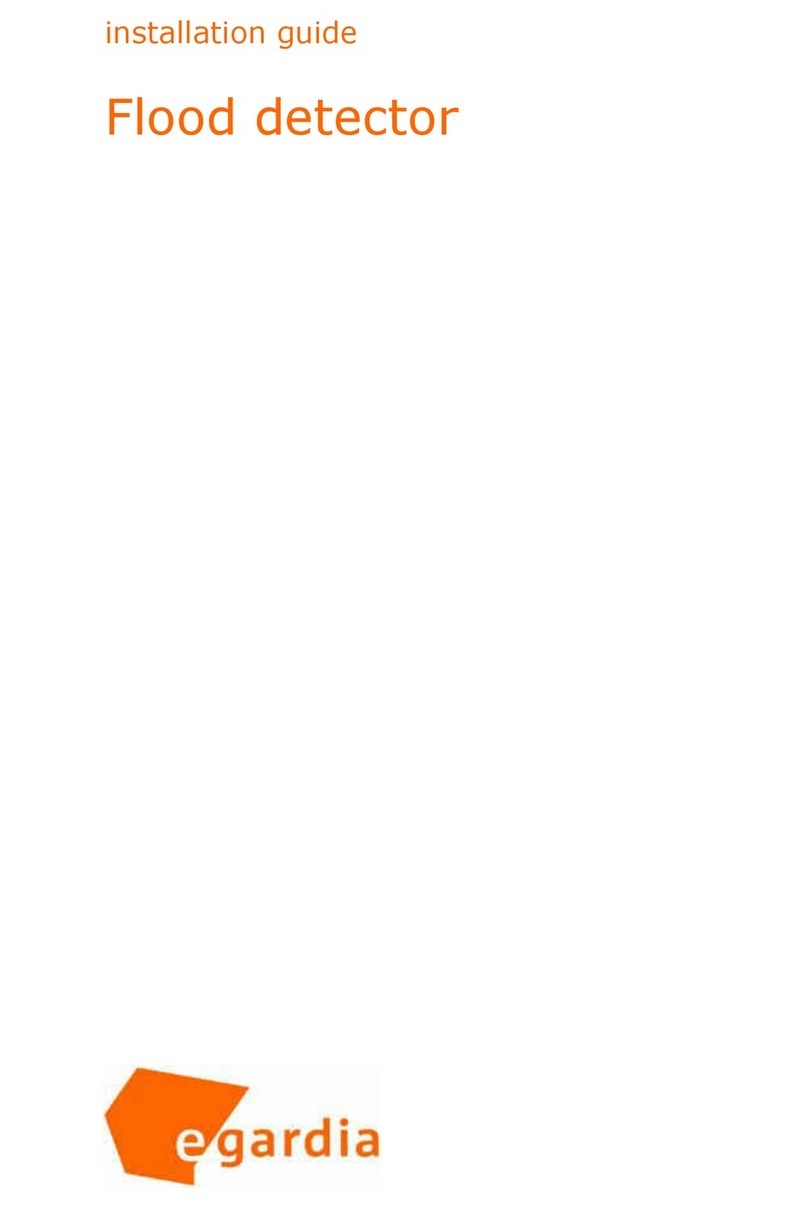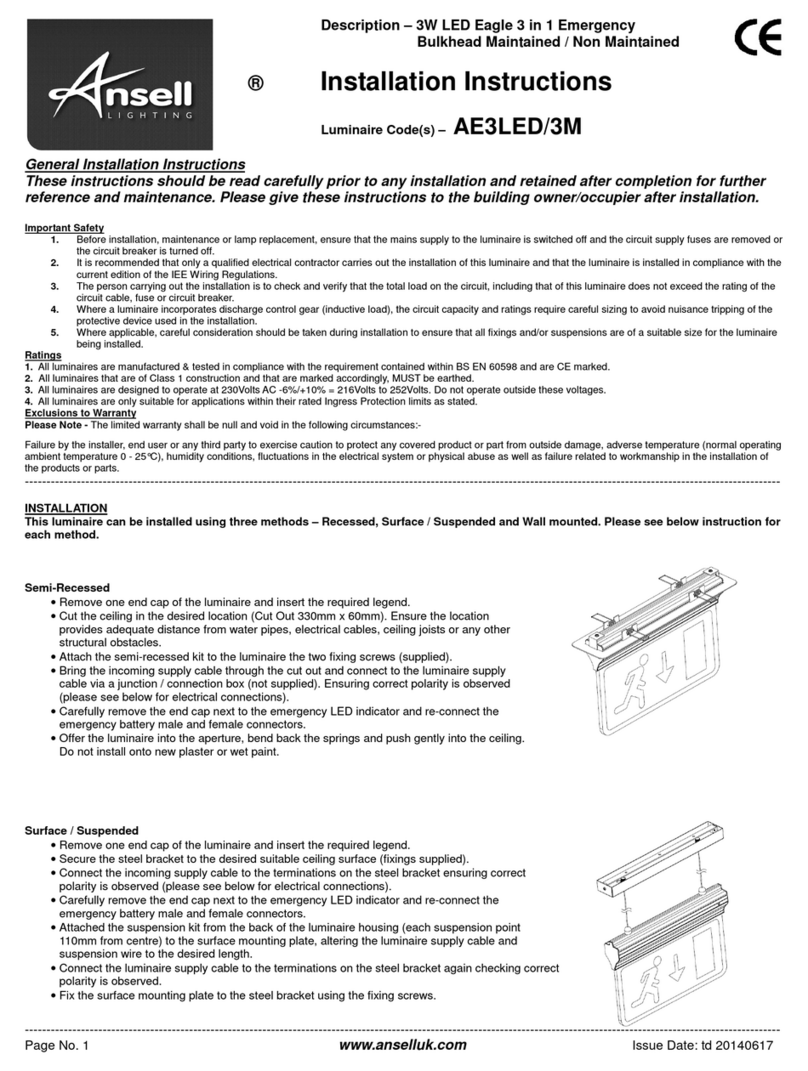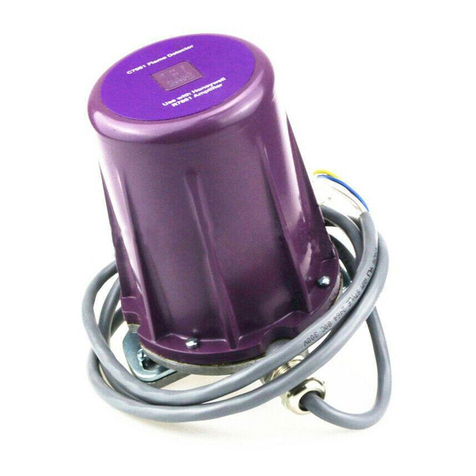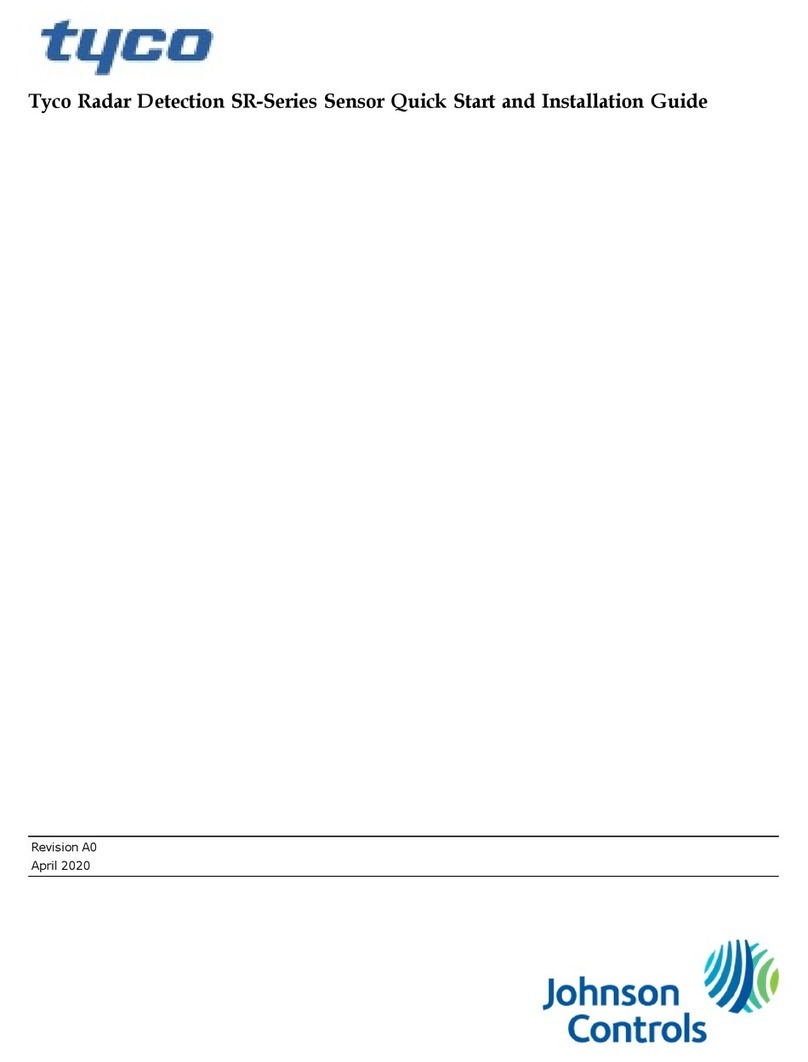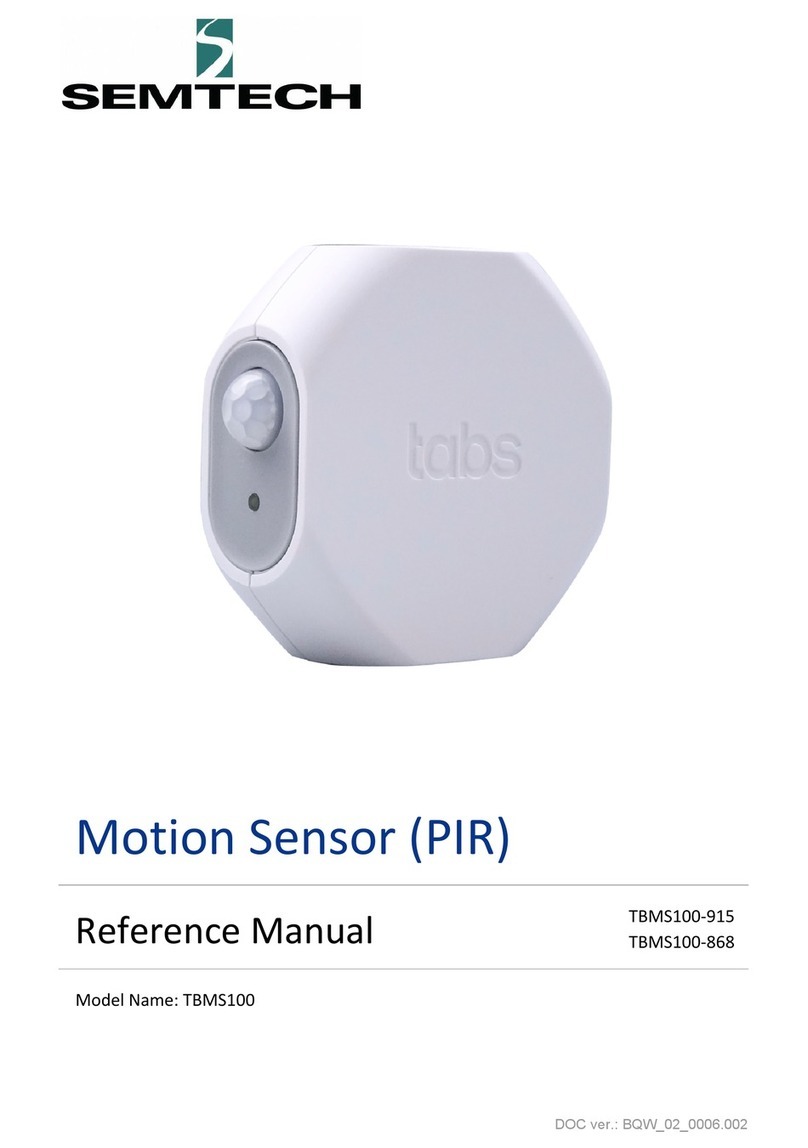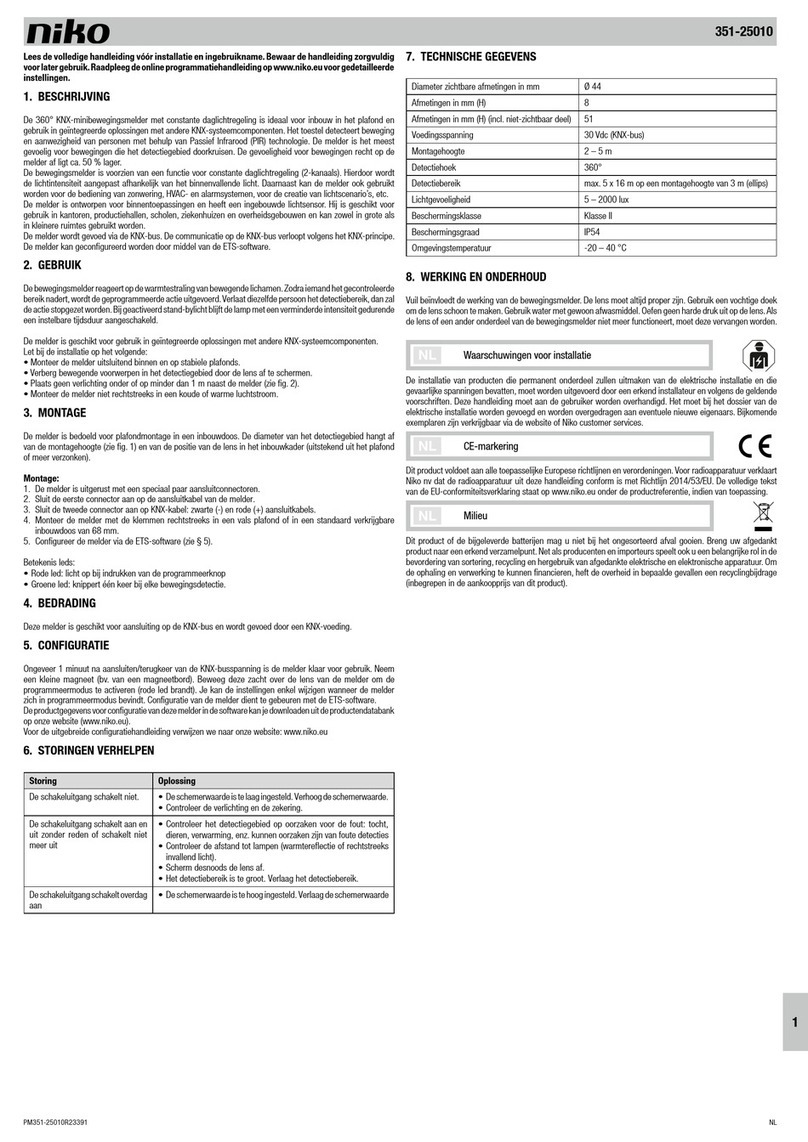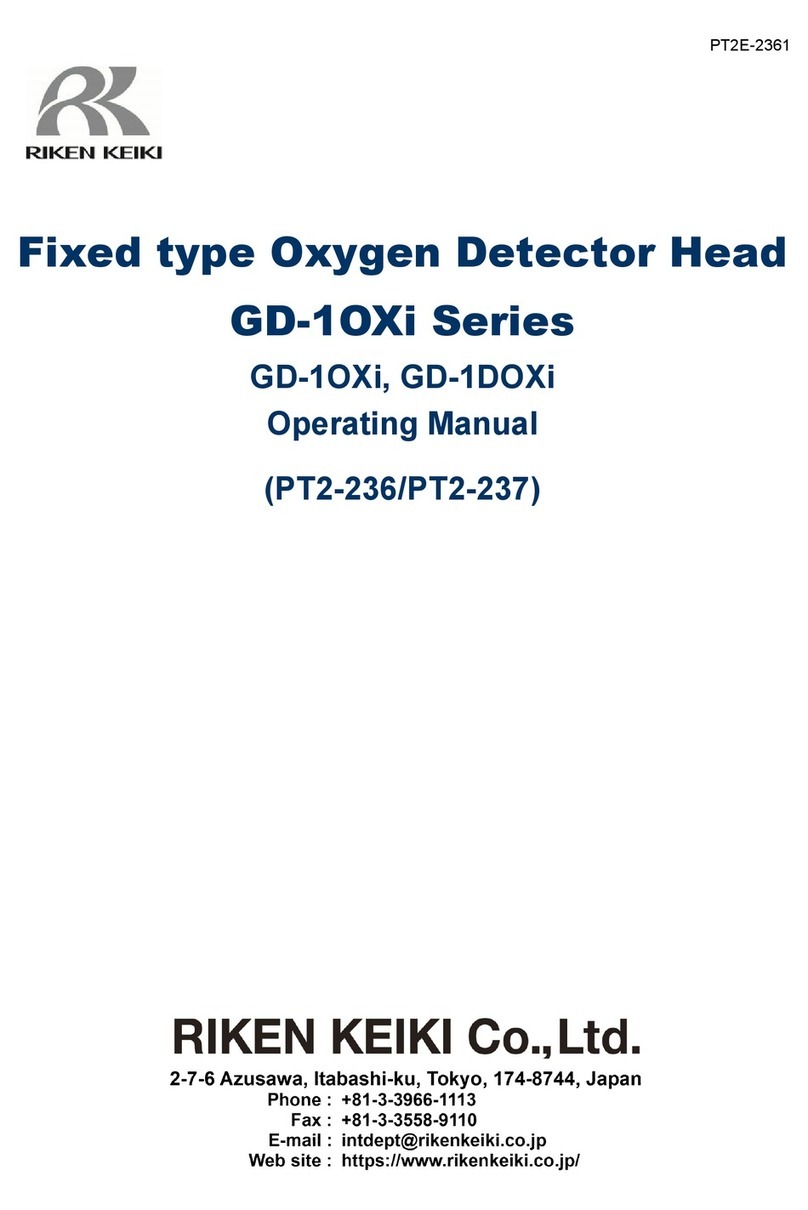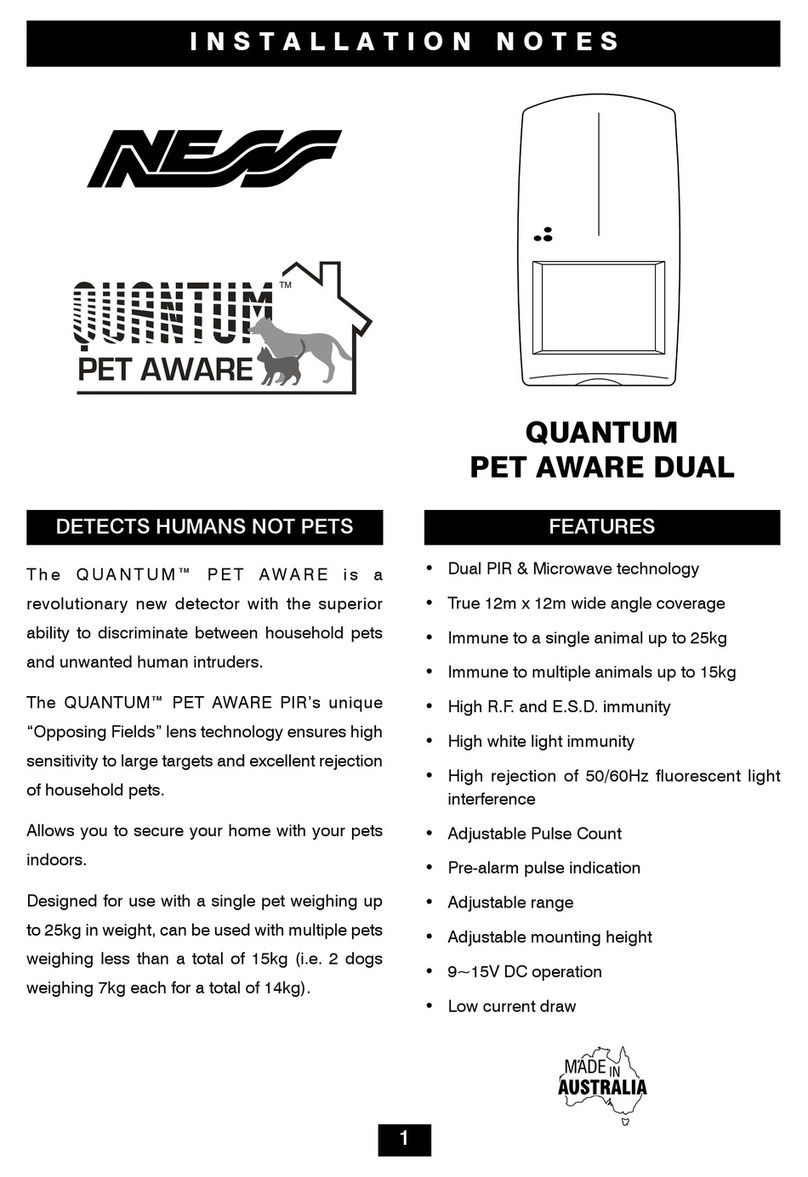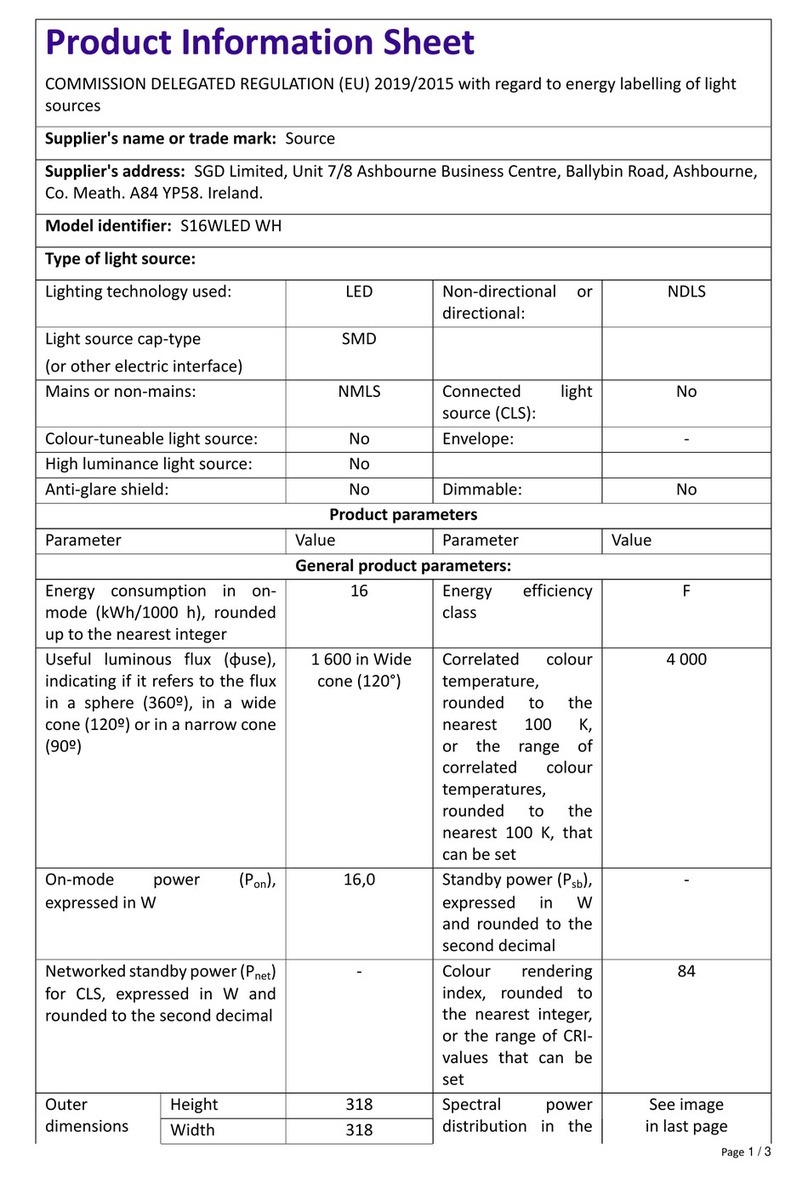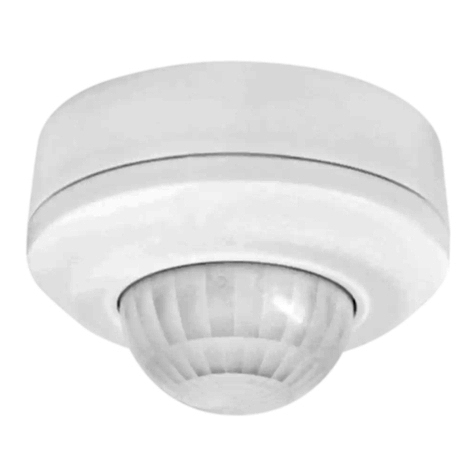GasTech Cannonball3 User manual

Reference Manual
Cannonball3
Multi Gas Detector
http://www.gastech.com.au
24 Baretta Rd
Wangara Western Australia 6065
GasTech Australia Pty Ltd
Fax 1800 999 903
Tel 1800 999 902

1
THE Cannonball3 PERSONAL PORTABLE GAS DETECTOR HAS BEEN DESIGNED FOR
THE DETECTION OF DEFICIENCIES OF OXYGEN, ACCUMULATIONS OF FLAMMABLE
GASES AND VAPORS AND ACCUMULATIONS OF TOXIC VAPORS.
IN ORDER TO ENSURE THAT THE USER IS PROPERLY WARNED OF
POTENTIALLY DANGEROUS ATMOSPHERIC CONDITIONS, IT IS ESSENTIAL
THAT THE INSTRUCTIONS IN THIS REFERENCE MANUAL BE READ, FULLY
UNDERSTOOD, AND FOLLOWED.
FOR INSTRUMENTS WITH DILUTION CAPABILITY, SEE THE CANNONBALL3
DILUTION MANUAL - SPERIAN INSTRUMENTATION PART NUMBER 13-186.
FOR INSTRUMENTS INCLUDING THE HC/LEL SENSOR, SEE THE HC/LEL
ADDENDUM TO THE CANNONBALL3 REFERENCE MANUAL - SPERIAN
INSTRUMENTATION PART NUMBER 13-236.
Cannonball3 Reference Manual
Version 1.50
Copyright 2009
Sperian Instrumentation, LLC
Middletown, Connecticut 06457
All rights reserved.
No page or part of this operation manual may be reproduced in any form
without written permission of the copyright owner shown above.
Patent Information
The Cannonball3 is protected by United States Patent Number 6,604,405.

2
Table of Contents
Signal Words __________________________________________________________ 6
Warnings 6
Chapter 1.Description ___________________________________________________ 7
1.1 Cannonball3 capabilities _________________________________________________7
1.2 Methods of sampling ____________________________________________________7
1.3 Multi-sensor capability __________________________________________________ 7
1.4 Calibration ____________________________________________________________ 7
1.5 Alarm logic ____________________________________________________________7
1.5.1 Alarm latch _________________________________________________________________________ 7
1.5.2 Atmospheric hazard alarms_____________________________________________________________ 7
1.5.3 Sensor overrange alarms.______________________________________________________________ 8
1.5.4 Low battery alarms ___________________________________________________________________ 8
1.5.5 Calibration reminder __________________________________________________________________ 8
1.5.6 Other alarms and special microprocessor features___________________________________________ 8
1.6 Other electronic safeguards ______________________________________________8
1.6.1 Security beep _______________________________________________________________________ 9
1.7 Classification for intrinsic safety __________________________________________ 9
1.8 Sensors_______________________________________________________________ 9
1.9 Continuous sample draw pump ___________________________________________ 9
1.10 Black box data recorder _________________________________________________9
1.11 Cannonball3 design components__________________________________________ 9
1.12 Cannonball3 accessories _______________________________________________10
1.12.1 Alkaline Cannonball3 detectors_________________________________________________________ 10
1.12.2 NiMH Cannonball3 detectors___________________________________________________________ 10
Chapter 2.Basic operation ______________________________________________ 10
2.1 Operational warnings and cautions _______________________________________ 10
2.2 On and off sequences __________________________________________________11
2.2.1 Start-up sequence___________________________________________________________________ 11
2.2.1.1 Other start-up screens _____________________________________________________________ 12
2.2.1.1.1 “Non-standard alarms” ________________________________________________________ 12
2.2.1.1.2 “Warning Sensor Needs Cal” ___________________________________________________ 12
2.2.2 Shut-down sequence_________________________________________________________________ 13
2.3 Operating modes ______________________________________________________13
2.3.1 Text Only mode_____________________________________________________________________ 13
2.3.2 Basic mode ________________________________________________________________________ 14
2.3.3 Basic/Peak mode ___________________________________________________________________ 14
2.3.3.1 Peak readings____________________________________________________________________ 14
2.3.3.2 To reset peak readings_____________________________________________________________ 14
2.3.4 Technician mode____________________________________________________________________ 15
2.3.4.1 STEL __________________________________________________________________________ 15
2.3.4.2 TWA readings____________________________________________________________________ 15
2.3.4.3 Average readings _________________________________________________________________ 15
2.3.5 Changing operating modes____________________________________________________________ 15
2.4 Batteries _____________________________________________________________ 16
2.4.1 Alkaline batteries____________________________________________________________________ 16
2.4.1.1 Replacing alkaline batteries _________________________________________________________ 16
2.4.2 NiMH rechargeable battery ____________________________________________________________ 16
2.4.2.1 Storage guidelines for the NiMH battery. _______________________________________________ 16

3
2.4.2.2 Charging guidelines for NiMH battery__________________________________________________ 17
2.4.2.3 Charging procedure for NiMH battery__________________________________________________ 17
2.4.3 Low battery alarms __________________________________________________________________ 17
2.5 Methods of sampling ___________________________________________________17
2.5.1 Protective “low flow” shut-downs________________________________________________________ 18
2.5.2 Sample probe assembly ______________________________________________________________ 18
2.5.2.1 Changing sample probe filters _______________________________________________________ 18
2.5.2.2 Changing sample probe tubes _______________________________________________________ 18
2.5.3 Pump modules _____________________________________________________________________ 19
2.5.3.1 Replacing the pump module_________________________________________________________ 19
2.6 EEPROM equipped “Smart Sensors” ______________________________________ 19
2.6.1 Identification of sensor type____________________________________________________________ 19
2.6.2 Other information stored in the sensor EEPROM ___________________________________________ 19
2.6.3 Sensor removal and replacement _______________________________________________________ 19
2.6.4 Missing sensor _____________________________________________________________________ 20
2.6.5 “Sensor not found”___________________________________________________________________ 20
Chapter 3.Advanced Functions __________________________________________ 20
3.1 The Main Menu________________________________________________________20
3.1.1 Entering the Main Menu ______________________________________________________________ 20
3.2 The Screen Menu ______________________________________________________ 20
3.2.1 Entering the Screen Menu_____________________________________________________________ 21
3.2.2 Adjusting the contrast ________________________________________________________________ 21
3.2.3 Adjusting the backlight _______________________________________________________________ 21
3.2.3.1 Backlight ON Always ______________________________________________________________ 21
3.2.3.2 Adjusting the backlight interval_______________________________________________________ 22
3.3 The Calibration Menu___________________________________________________22
3.4 The View Menu________________________________________________________22
3.4.1 Entering the View Menu ______________________________________________________________ 22
3.4.2 View alarm levels ___________________________________________________________________ 23
3.4.3 View battery voltage _________________________________________________________________ 23
3.4.4 View service information ______________________________________________________________ 23
3.4.5 View software version________________________________________________________________ 23
3.5 The Alarms Menu ______________________________________________________24
3.5.1 Entering the Alarms Menu_____________________________________________________________ 24
3.5.2 Custom alarm settings________________________________________________________________ 24
3.5.3 Alarm and OK latches ________________________________________________________________ 25
3.5.3.1 Alarm latch settings _______________________________________________________________ 25
3.5.3.2 OK latch settings _________________________________________________________________ 25
3.5.4 Default alarm settings ________________________________________________________________ 26
3.5.4.1 Restore factory default alarm settings _________________________________________________ 26
3.5.5 Temperature alarm __________________________________________________________________ 26
3.5.6 Warning Alarms_____________________________________________________________________ 27
3.5.6.1 Enable/disable warning alarms_______________________________________________________ 27
3.5.6.2 Adjust warning alarm levels _________________________________________________________ 28
3.5.6.3 Timeout adjustment _______________________________________________________________ 28
3.6 The Time Menu________________________________________________________ 29
3.6.1 Entering the Time Menu ______________________________________________________________ 29
3.6.2 Time and date settings _______________________________________________________________ 29
3.6.3 Service date settings_________________________________________________________________ 30
3.6.3.1 Enable/Disable sensor service due date settings_________________________________________ 30
3.6.3.2 Change sensor service due dates ____________________________________________________ 30
3.6.4 Communications ____________________________________________________________________ 31
3.7 The Options Menu _____________________________________________________ 31
3.7.1 Entering the Options Menu ____________________________________________________________ 31
3.7.2 User modes________________________________________________________________________ 32

4
3.7.2.1 Overview of user modes____________________________________________________________ 32
3.7.2.2 Text Only mode __________________________________________________________________ 32
3.7.2.3 Basic mode______________________________________________________________________ 32
3.7.2.4 Basic/Peak mode _________________________________________________________________ 33
3.7.2.4.1 Peak readings_______________________________________________________________ 33
3.7.2.5 Technician Mode _________________________________________________________________ 33
3.7.2.5.1 STEL Readings______________________________________________________________ 33
3.7.2.5.2 TWA readings_______________________________________________________________ 33
3.7.2.5.3 Average readings ____________________________________________________________ 33
3.7.2.6 Changing the user mode ___________________________________________________________ 33
3.7.3 Security beep ______________________________________________________________________ 34
3.7.3.1 Adjusting the security beep__________________________________________________________ 34
3.7.4 Passcode _________________________________________________________________________ 35
3.7.4.1 Change passcode setting___________________________________________________________ 35
3.7.4.2 Changing the passcode ____________________________________________________________ 36
3.7.5 Language _________________________________________________________________________ 37
3.7.5.1 Entering the Language Menu ________________________________________________________ 37
3.7.6 DECIMAL: Changing the precision of the toxic sensor readout_________________________________ 37
3.7.7 Sensor enable/disable________________________________________________________________ 38
3.8 ID Info _______________________________________________________________39
3.8.1 Entering the ID Info Menu _____________________________________________________________ 39
3.8.2 User and location list settings __________________________________________________________ 39
3.8.3 Selecting a user or location ID__________________________________________________________ 41
Chapter 4.Calibration___________________________________________________ 43
4.1 Verification of accuracy_________________________________________________ 43
4.2 Effect of contaminants on Cannonball3 sensors_____________________________ 43
4.2.1 Effects of contaminants on oxygen sensors _______________________________________________ 43
4.2.2 Effects of contaminants on combustible sensors____________________________________________ 43
4.2.3 Effects of high concentrations of combustible gas on the combustible sensor _____________________ 44
4.2.4 Effects of contaminants on toxic gas sensors ______________________________________________ 44
4.3 Single sensors capable of monitoring for two different gases__________________ 44
4.3.1 Using one sensor to monitor for carbon monoxide and hydrogen sulfide _________________________ 44
4.3.1.1 Duo-Tox dual purpose carbon monoxide / hydrogen sulfide sensor___________________________ 44
4.3.1.2 “CO Plus” dual purpose carbon monoxide/hydrogen sulfide sensor___________________________ 44
4.3.1.2.1 Relative response of the CO Plus sensor to carbon monoxide and hydrogen sulfide_________ 45
4.3.2 Cl2and ClO2 sensors_________________________________________________________________ 45
4.4 Functional (bump) test__________________________________________________ 45
4.5 Automatic calibration___________________________________________________46
4.5.1 Automatic fresh air calibration sequence _________________________________________________ 46
4.5.1.1 Reading “Too High” or “Too Low” for zero adjust_________________________________________ 47
4.5.2 Automatic span calibration sequence ____________________________________________________ 47
4.5.3 Automatic span calibration with more than one gas source ___________________________________ 49
4.6 Manual calibration _____________________________________________________ 49
4.6.1 Manual fresh air calibration procedure ___________________________________________________ 49
4.6.1.1 Shortcuts to the manual fresh air calibration procedures _____________________________________ 50
4.6.1.1.1 Shortcut to fresh air calibration while in normal operation______________________________ 50
4.6.1.1.2 Shortcut to Main Menu while turning the Cannonball3 on______________________________ 50
4.6.2 Manual span calibration procedures _____________________________________________________ 50
4.6.3 O2zero calibration___________________________________________________________________ 52
4.7 The Calibration Menu___________________________________________________53
4.7.1 Entering the Calibration Menu__________________________________________________________ 53
4.7.2 Gas values ________________________________________________________________________ 53
4.7.2.1 Changing the combustible gas readout from LEL to CH4(or vice-versa) _______________________ 54
4.7.2.2 Changing the direct reading setting of the CO Plus sensor from CO to H2S ____________________ 56
4.7.3 Calibration history ___________________________________________________________________ 58

5
4.7.4 Calibration reminder _________________________________________________________________ 59
4.7.4.1 Remind Interval __________________________________________________________________ 59
4.7.4.2 Repeat Reminder _________________________________________________________________ 60
Chapter 5.Record Keeping ______________________________________________ 61
5.1 Overview of record keeping options_______________________________________ 61
5.2 Black box data recorder ________________________________________________ 61
5.3 Datalogger upgrade ____________________________________________________61
5.3.1 BioTrak Database Software____________________________________________________________ 61
5.3.2 The Datalogger Menu ________________________________________________________________ 62
5.3.2.1 Setting the datalogging interval ______________________________________________________ 62
5.3.2.1.1 Disabling the datalogger ______________________________________________________ 63
5.3.2.2 Clearing the Datalogger ____________________________________________________________ 64
5.3.2.3 Setting the time and date ___________________________________________________________ 64
5.3.2.4 Sessions________________________________________________________________________ 65
5.3.2.5 Service Date_____________________________________________________________________ 66
5.3.2.5.1 Enable/disable sensor service due date settings ___________________________________ 66
5.3.2.5.2 Change sensor service dates __________________________________________________ 66
5.3.2.6 Communications mode_____________________________________________________________ 67
Chapter 6. Basic maintenance ___________________________________________ 68
6.1 Sensors______________________________________________________________ 68
6.1.1 Sensor replacement _________________________________________________________________ 68
6.1.2 New sensor releases_________________________________________________________________ 68
6.1.3. Troubleshooting sensor problems_______________________________________________________ 69
6.1.3.1 Can’t make a “One Button” automatic fresh air adjustment _________________________________ 69
6.1.4 Sensor caps _______________________________________________________________________ 69
6.2 Internal motorized pump ________________________________________________ 69
6.2.1 Pump replacement __________________________________________________________________ 69
6.2.2 Internal filter replacement _____________________________________________________________ 69
6.2.3 Pump failure at start up_______________________________________________________________ 69
6.2.4. Can’t resume normal operation after a “Low Flow” shut down _________________________________ 70
6.3 Sample probe assembly ________________________________________________ 70
6.3.1 Changing sample probe filters__________________________________________________________ 71
6.3.2 Changing sample probe tubes__________________________________________________________ 71
6.4 O-Rings______________________________________________________________ 71
6.4.1 Removal of o-rings __________________________________________________________________ 71
6.4.2. Inspection and cleaning of o-rings_______________________________________________________ 71
6.4.3 Lubrication of o-rings_________________________________________________________________ 71
6.4.4 Recommended lubricants _____________________________________________________________ 71
6.4.5 O-ring kits _________________________________________________________________________ 71
6.5 Returning your Cannonball3 to Sperian Instrumentation for service or repair_____ 72
Appendices___________________________________________________________ 73
Appendix A- Toxic gas measurement - Ceilings, TWAs and STELs __________________ 73
Appendix B Electrochemical Sensor Cross Sensitivity Data _______________________75
Appendix C Cannonball3 sensors ranges ______________________________________76
Appendix D LEL Correction Factors___________________________________________ 76
Appendix E: Calibration Frequency Recommendation_____________________________ 77
Appendix F Sperian Instrumentation Warranty Gas Detection Products______________78

6
Signal Words
The following signal words, as defined by ANSI Z535.4-1998, are used in the Cannonball3 Reference
Manual.
indicates an imminently hazardous situation which, if not avoided, will result in
death or serious injury.
indicates a potentially hazardous situation which, if not avoided, could result in
death or serious injury.
indicates a potentially hazardous situation, which if not avoided, may result in
moderate or minor injury.
CAUTIONused without the safety alert symbol indicates a potentially hazardous situation
which, if not avoided, may result in property damage.
Warnings
1. The Cannonball3 personal, portable gas detector has been designed for the detection of
dangerous atmospheric conditions. An alarm condition indicates the presence of a potentially life-threatening
hazard and should be taken very seriously. Failure to immediately leave the area during an alarm condition may
result in serious injury or death.
2. In the event of an alarm condition it is important to follow established procedures. The safest
course of action is to immediately leave the affected area, and to return only after further testing determines that the
area is once again safe for entry. Failure to immediately leave the area during an alarm condition may result in
serious injury or death.
3. Use only Energizer E95 or EN95, Duracell MN1300, or Duracell PC1300, 1.5V D cell Alkaline
batteries in the Cannonball3. Substitution of batteries may impair intrinsic safety.
4. The accuracy of the Cannonball3 should be checked periodically with known concentration
calibration gas. Failure to check accuracy can lead to inaccurate and potentially dangerous readings.
5. The accuracy of the Cannonball3 should be checked immediately following any known exposure
to contaminants by testing with known concentration test gas before further use. Failure to check accuracy can
lead to inaccurate and potentially dangerous readings.
6. A sensor that cannot be calibrated or is found to be out of tolerance should be replaced
immediately. An instrument that fails calibration may not be used until testing with known concentration test gas
determines that accuracy has been restored, and the instrument is once again fit for use.
7. Do not reset the calibration gas concentration unless you are using a calibration gas
concentration that differs from the one that is normally supplied by Sperian Instrumentation for use in calibrating the
Cannonball3. Use of inappropriate calibration gas may lead to in accurate and potentially dangerous readings.
Customers are strongly urged to use only Sperian Instrumentation calibration materials when calibrating the
Cannonball3. Use of non-standard calibration gas and/or calibration kit components can lead to dangerously
inaccurate readings and may void the standard Sperian Instrumentation warranty.
8. Use of non-standard calibration gas and/or calibration kit components when calibrating the
Cannonball3 can lead to inaccurate and potentially dangerous readings and may void the standard Sperian
Instrumentation warranty.
Sperian Instrumentation offers calibration kits and long-lasting cylinders of test gas specifically developed for easy
Cannonball3 calibration. Customers are strongly urged to use only Sperian Instrumentation calibration materials when
calibrating the Cannonball3.
9. Substitution of components may impair intrinsic safety.
10. For safety reasons this equipment must be operated and serviced by qualified personnel only.
Read and understand this reference manual before operating or servicing the Cannonball3.
11. A rapid up-scale reading followed by a declining or erratic reading may indicate a hazardous
combustible gas concentration that exceeds the Cannonball3’s zero to 100 percent LEL detection range for units
without a dilution pump, or zero to approximately 200 percent detection range for units with a dilution pump. The
safest course of action is to immediately leave the affected area, and to return only after further testing determines
that the area is once again safe for entry.

7
Chapter 1. Description
1.1 Cannonball3 capabilities
The Cannonball3 is a gas detector that can be configured to
meet a wide variety of requirements. This chapter provides an
overview of many of the features of the Cannonball3. More
detailed descriptions of the features of the Cannonball3 are
contained in the subsequent chapters of this manual.
1.2 Methods of sampling
Every Cannonball3 includes a built-in continuous sample draw
pump. Since the Cannonball3’s sensor compartment is
contained within the instrument, the gas sample must be drawn
into the instrument by the pump through a probe assembly that
is attached to theinlet coupling on the front of the unit.
Once turned on, the Cannonball3 monitors continuously. The
Cannonball3’s sensors react quickly to changes in the
concentrations of the gases being measured. This type of
operation monitors only the atmosphere in the immediate area
of the end of the probe assembly.
For more details on sampling the atmosphere, see section
2.5.
A detailed description of the Cannonball3 probe assembly
is given in section 6.3.
1.3 Multi-sensor capability
The Cannonball3 can be configured to simultaneously monitor
oxygen, combustible gases and up to three toxic gases.
Sensors can be added, removed, changed, or replaced in the
field. The Cannonball3 microprocessor and “Smart Sensor”
circuitry eliminates the need for laborious set-up procedures.
Accuracy of the Cannonball3 should
be checked periodically with known concentration
calibration gas. Failure to check accuracy can lead to
inaccurate and potentially dangerous readings.
Calibration procedures are discussed in detail in Chapter
4.
The Cannonball3 uses electrochemical toxic sensors that have
been designed to minimize the effects of common interfering
gases. These sensors provide accurate, dependable readings
for toxic gases commonly encountered during confined space
entry and other industrial applications. Toxic sensors available
for use in the Cannonball3 include hydrogen sulfide (H2S),
carbon monoxide (CO), sulfur dioxide (SO2), phosphine (PH3),
ammonia (NH3), chlorine (Cl2), chlorine dioxide (ClO2),
hydrogen cyanide (HCN) and nitrogen dioxide (NO2).
In addition to sensors designed to measure specific toxic
hazards, Sperian Instrumentation also offers two different
sensors that allow for the simultaneous detection of both
carbon monoxide and hydrogen sulfide.
The “Duo-Tox” sensor is a dual channel electrochemical
sensor designed to detect both carbon monoxide and
hydrogen sulfide. The Duo-Tox allows one sensor port to be
used for discriminate detection of both carbon monoxide and
hydrogen sulfide without cross interference.
For more information on the Duo-Tox sensor see section
4.3.1.1.
The “CO Plus” sensor is a single channel electrochemical
sensor. The CO Plus is ideal for situations requiring the use of
a single sensor to monitor for both carbon monoxide and
hydrogen sulfide, but where the user does not need to know
specifically which gas is present.
For more information on the CO Plus sensor see section
4.3.1.2.
Different measurement units are used depending on the gas
being measured.
Type of Hazard Measurement unit
Oxygen (O2) Percentage of air by volume
Combustible gas Percentage of lower
explosive limit (LEL)
All toxic sensors Parts per million in air
Table 1.3: Cannonball3 Units of Measurement
Sensor configuration procedures are discussed in greater
detail in Chapter 2.
1.4 Calibration
The Cannonball3 detector features fully automatic fresh air and
span calibration. Accuracy of the Cannonball3 should
be checked periodically with known concentration
calibration gas. Failure to check accuracy can lead to
inaccurate and potentially dangerous readings.
Calibration procedures are discussed in Chapter 4.
Sperian Instrumentation’s calibration frequency
recommendations are discussed in Appendix E.
Use of these procedures is reserved for authorized
personnel.
1.5 Alarm logic
Cannonball3 gas alarms are user-adjustable and may be set
anywhere within the range of the specific sensor type. When
an alarm set point is exceeded a loud audible alarm sounds,
and the bright red LED alarm lights flash.
The procedure for adjusting alarm levels is covered in
section 3.5.2.
1.5.1 Alarm latch
The Cannonball3 includes a latching alarm that can be enabled
or disabled according to the needs of the user. When the
Cannonball3’s alarm latch is enabled, the audible and visible
alarm will continue to sound after the atmospheric hazard has
cleared. To reset the instrument, simply press the MODE
button. If the Cannonball3’s alarm latch is disabled and the
alarm condition is no longer present, the instrument
automatically returns to normal operation, and the visible and
audible alarms cease without further input from the user.
The procedure for changing alarm latch settings is
covered in section 3.5.3.
1.5.2 Atmospheric hazard alarms
The Cannonball3 personal, portable
gas detector has been designed for the detection of
oxygen deficiencies, and flammable gas and toxic vapor
accumulations. An alarm condition indicating the
presence of one or more of these potentially life-
threatening hazards should be taken very seriously.
In the event of an alarm condition it is
important to follow established procedures. The safest
course of action is to immediately leave the affected area,
and to return only after further testing determines that the
area is once again safe for entry.
A rapid up-scale reading followed by a
declining or erratic reading may indicate a hazardous
combustible gas concentration that exceeds the

8
Cannonball3’s zero to 100 percent LEL detection range for
units without a dilution pump, or zero to approximately
200 percent detection range for units with a dilution pump.
The safest course of action is to immediately leave the
affected area, and to return only after further testing
determines that the area is once again safe for entry.
The combustible gas alarm is activated when the percent LEL
(Lower Explosive Limit) gas concentration exceeds the pre-set
alarm level.
Two oxygen alarm set points have been provided; one for low
concentrations associated with oxygen deficiencies and one for
high concentrations associated with oxygen enrichments.
Two additional oxygen alarm set points have been provided for
Cannonball3 instruments equipped with the dilution pump for
use in inert or nearly inert atmospheres.
Three alarm set points have been provided for each toxic gas
monitored: TWA (Time Weighted Average), STEL (Short Term
Exposure Limit), and Ceiling.
Appendix A discusses alarm levels.
The procedure for adjusting alarm settings is covered in
section 3.5.2.
1.5.3 Sensor overrange alarms.
The Cannonball3 will go into alarm if a sensor is exposed to a
concentration of gas that exceeds its established range. If the
peak alarm is enabled it will go off before an overrange alarm
provided a STEL or TWA alarm is not activated first. If the
peak alarm is disabled and a toxic sensor goes into overrange
alarm a “SENSOR OUT OF RANGE” message will appear at
the bottom of the display while the audible and visible are
activated. The maximum range value will be displayed for the
sensor in alarm. If the LEL sensor goes into overrange alarm,
the message “LEL OVERRANGE” will appear at the bottom of
the screen, both the audible alarm and the flashing LED alarms
will be activated and an “X” will appear on the LCD in the place
of the numeric reading for the LEL sensor.
In the event of an alarm condition it is
important to follow established procedures. The safest
course of action is to immediately leave the affected area,
and return only after further testing determines that the
area is once again safe for entry.
In the event of an LEL overrange
alarm the Cannonball3 must be turned off, brought to an
area that is known to be safe and then turned on again to
reset the alarm.
Note: The Cannonball3 features automatic warning against
LEL sensor failure due to lack of oxygen. In the case of
oxygen levels below the safe limit for the LEL sensor to
operate, the Cannonball3 will display a message indicating
that O2is too low for LEL to operate.
1.5.4 Low battery alarms
Note: The voltage figures given below are for Cannonball3
instruments with firmware version 1.55 and may be
slightly different for units with other versions of
instrument firmware.
The Cannonball3 includes low battery alarms that are activated
whenever battery voltage approaches a level that will soon
lead to instrument shut down. When the battery voltage is
reduced to approximately 5.15 volts in alkaline units, or 4.82
volts in NiMH rechargeable units, an audible alarm will sound,
and the display screen will indicate that a low battery condition
exists. At this stage, the low battery alarms may be silenced
for up tofifteen minutes by pressing the MODE button. After
the first low battery alarm, the alarm will sound again every
fifteen minutes until the voltage drops to the “Very Low Battery”
level.
The “Very Low Battery” level occurs when the battery voltage
drops to 5.06 volts in alkaline units, or 4.75 volts in NiMH
rechargeable units. Due to the risk of imminent shut down,
when the battery voltage reaches the “Very Low Battery” level
it is no longer possible to silence the low battery alarms. At
this point, it is necessary to either immediately leave the
hazardous area in which the instrument is being used or to
immediately install a new battery pack with a charge sufficient
to avoid the low battery alarms.
When the voltage drops to 5.00 volts in alkaline units, or 4.73
volts in NiMH rechargeable units. the Cannonball3 will display
a "Dead Battery" message to warn the user of imminent shut
down. The instrument will then automatically turn itself off.
After any low battery alarm the batteries should be replaced if
the Cannonball3 is equipped with alkaline batteries or the
battery should be recharged if the Cannonball3 is equipped
with a NiMH rechargeable battery.
Use only Energizer E95 or EN95,
Duracell MN1300, or Duracell PC1300, 1.5V D cell Alkaline
batteries in the Cannonball3. Substitution of batteries may
impair intrinsic safety.
1.5.5 Calibration reminder
The Cannonball3 has a calibration reminder to let the user
know that the instrument is due for calibration. The reminder
can be set to any interval between 1 and 180 days, or can be
disabled entirely. Additional controls allow the user to
determine if the reminder will be shown once per operating
session, or every 15 minutes. Successful calibration resets the
reminder.
See section 4.7.4 for further details about the calibration
reminder.
1.5.6 Other alarms and special microprocessor features
Cannonball3 software includes a number of additional alarms
designed to ensure the proper use of the instrument. When
the Cannonball3 detects that an electronic fault or failure
condition has occurred, the proper audible and visible alarms
are activated and an explanatory message is displayed.
The Cannonball3 is designed to detect
potentially life threatening atmospheric conditions. Any
alarm condition should be taken seriously. The safest
course of action is to immediately leave the affected area,
and return only after further testing determines that the
area is once again safe for entry.
1.6 Other electronic safeguards
Several automatic programs prevent tampering and misuse of
the Cannonball3 by unauthorized persons. Each time the
detector is turned on, the Cannonball3 automatically tests the
LED alarm lights and audible alarm. The battery is monitored
continuously for proper voltage. The Cannonball3 also
monitors the connection of sensors that are currently installed.
The detection of any electronic faults causes the activation of
the audible and visible alarms and causes the display of the
appropriate explanatory message.

9
1.6.1 Security beep
The Cannonball3 offers a security beep that may be configured
to “beep” at defined intervals to indicate that the instrument is
turned on.
Optional set-up choices, including security beep settings,
are accessed through the Options Menu. See section 3.7
for details.
1.7 Classification for intrinsic safety
The Cannonball3 has been classified for intrinsic safety by the
following testing laboratories:
Underwriters Laboratories, Inc. (file number E109447) for
use in Hazardous Locations Class I, Division 1, Groups A,
B, C, and D Temp T3C.
CSA (file number 159202) Class I Division 1 Groups
A,B,C,D Exia Temp T3C.
1.8 Sensors
The Cannonball3 can be configured to measure oxygen,
combustible gas, and up to three additional toxic gases. Up to
four sensors can be installed in the Cannonball3. With the
“Duo-Tox” dual channel CO/H2S sensor installed, the
instrument is capable of displaying readings for up to five
different channels of detection: O2, LEL, CO, H2S and one
other toxic sensor. The sensor configuration of the
Cannonball3 can be specified at the time of purchase, or
changed in the field by appropriately trained personnel.
Accuracy of the Cannonball3 should
be checked periodically with known concentration
calibration gas. Failure to check accuracy can lead to
inaccurate and potentially dangerous readings.
Calibration procedures are discussed in detail in Chapter
4.
1.9 Continuous sample draw pump
Every Cannonball3 includes a built-in continuous sample draw
pump. Since the Cannonball3’s sensor compartment is
contained within the instrument, the gas sample must be drawn
into the instrument by the pump through a probe assembly that
is attached to theinlet coupling on the front of the unit.
The pump contains a pressure sensor that detects restrictions
in airflow caused by water or other fluids being drawn into the
unit and immediately acts to shut the pump off in order to
protect the sensors, pump, and other Cannonball3 components
from damage.
Pump status is continuously monitored by the Cannonball3
microprocessor. Low flow or other pump fault conditions
activate audible and visible alarms and cause the display of the
appropriate explanatory message.
Cannonball3 instruments equipped with alkaline battery packs
and fresh D-cell alkaline batteries are designed to provide at
least 24 hours of continuous operation even when the
instrument is operated in low light conditions and the backlight
is continuously on. Use only Energizer E95 or EN95,
Duracell MN1300, or Duracell PC1300, 1.5V D cell Alkaline
batteries in the Cannonball3. Substitution of batteries
may impair intrinsic safety.
Cannonball3 instruments equipped with NiMH rechargeable
battery packs are designed to provide at least 16 hours of
continuous operation between charges even when the
instrument is operated in low light conditions and the backlight
is continuously on.
1.10 Black box data recorder
Every Cannonball3 purchased without a datalogger includes a
“black box” data recorder that functions similarly to a
datalogger, with one important distinction: The data stored in a
Cannonball3 with a datalogger option can be accessed directly
by the user with Sperian Instrumentation’s Biotrak Database
Software. Instruments with the black box data recorder must
be sent back to Sperian Instrumentation for data retrieval.
If the data stored in a Cannonball3 equipped with a black box
data recorder is needed, simply call Sperian’s Instrument
Service Department at (800) 711-6776 for a return
authorization number and send the instrument back to Sperian
Instrumentation. Sperian Instrumentation will extract the data
from the instrument and print an incident report at no charge.
You only pay for shipping.
Datalogging functions are discussed in detail in Chapter 5.
1.11 Cannonball3 design components
Case: The instrument is enclosed in a solid ABS case with two
gaskets between its upper and lower sections. The first is a
water-resistant PVC gasket that protects against leakage or
exposure to dust and liquids. The second gasket is a metal-
braided O-ring that increases the Cannonball3’s immunity to
radio frequency interference.
Front face: The front face of the Cannonball3 houses the
graphics-capable LCD display, MODE button, four navigation
arrows, three alarm light ports, and the quick reference card.
LCD display: A large graphics-capable liquid crystal display
(LCD) shows readings, messages, menus and other
information. An automatically activated backlight allows the
display to be read in dim light conditions.
Alarm light: Three alarm light ports located on three different
sides of the Cannonball3 ensure that at least one of the alarm
light ports is visible from any angle.
Control buttons: The large oval push-button to the left of the
handle is the MODE button. The MODE button is used to turn
the Cannonball3 on and off, and to control many other basic
operations, including automatic calibration adjustments. The
four triangular navigation arrows are used to scroll or navigate
through additional menu choices and screens of information.
Sensor compartment: The sensor compartment is contained
within the Cannonball3 itself. Gas samples are drawn into the
Cannonball3 by the continuous sample pump through an
externally vented sensor compartment cover.
Audible alarm orifice: The audible alarm orifice is located on
the right side of the instrument.
Battery packs: Rechargeable and alkaline battery packs are
inserted at the base of the Cannonball3 and are held in place
with two retention screws.
Handle: The soft rubber handle provides a sure grip in any
condition.
Pump compartment: The sample and dilution diaphragm
pumps are housed in a field-replaceable assembly that is
accessible from the bottom of the instrument.
External filter compartment: The clear plastic compartment
on the front of the Cannonball3 provides visual access to the
filter compartment. When filters appear dirty, a single screw
provides access to the filter compartment for easy filter
replacement in the field.

10
Sample inlet coupling: The sample inlet coupling is a metal
quick disconnect fitting located at the front of the Cannonball3.
Sample draw probe assemblies must be attached to the
sample inlet coupling for the Cannonball3 to function properly.
1.12 Cannonball3 accessories
Each Cannonball3 is delivered in a foam-lined box containing
the Cannonball3 detector, sample probe assembly, 10 feet of
sample draw tubing with quick disconnect fitting, reference
manual, shoulder strap, replacement sample probe filters and
chosen battery pack.
1.12.1 Alkaline Cannonball3 detectors
Cannonball3 instruments purchased as alkaline instruments
include all of the standard accessories plus the alkaline battery
pack and a set of 5 disposable D-cell alkaline batteries.
1.12.2 NiMH Cannonball3 detectors
Cannonball3 instruments purchased as “NiMH” instruments
include all of the standard accessories plus the NiMH battery
pack and Cannonball3 fast charger.
Chapter 2. Basic operation
This chapter will cover how to use the Cannonball3 for safe
work in potentially hazardous atmospheres.
2.1 Operational warnings and cautions
1. The Cannonball3 personal,
portable gas detector has been designed for the
detection of dangerous atmospheric conditions. An
alarm condition indicates the presence of a potentially
life-threatening hazard and should be taken very
seriously. Failure to immediately leave the area during
an alarm condition may result in serious injury or
death.
2. In the event of an alarm condition
it is important to follow established procedures. The
safest course of action is to immediately leave the
affected area, and to return only after further testing
determines that the area is once again safe for entry.
Failure to immediately leave the area during an alarm
condition may result in serious injury or death.
3. Use only Energizer E95 or EN95,
Duracell MN1300, or Duracell PC1300, 1.5V D cell
Alkaline batteries in the Cannonball3. Substitution of
batteries may impair intrinsic safety.
4. The accuracy of the Cannonball3
should be checked periodically with known
concentration calibration gas. Failure to check
accuracy can lead to inaccurate and potentially
dangerous readings.
5. The accuracy of the Cannonball3
should be checked immediately following any known
exposure to contaminants by testing with known
concentration test gas before further use. Failure to
check accuracy can lead to inaccurate and potentially
dangerous readings.
6. A sensor that cannot be
calibrated or is found to be out of tolerance should be
replaced immediately. An instrument that fails
calibration may not be used until testing with known
concentration test gas determines that accuracy has
been restored, and the instrument is once again fit for
use.
7. Do not reset the calibration gas
concentration unless you are using a calibration gas
concentration that differs from the one that is
normally supplied by Sperian Instrumentation for use
in calibrating the Cannonball3. Use of inappropriate
calibration gas may lead to in accurate and potentially
dangerous readings.
Customers are strongly urged to use only Sperian
Instrumentation calibration materials when calibrating
the Cannonball3. Use of non-standard calibration gas
and/or calibration kit components can lead to
dangerously inaccurate readings and may void the
standard Sperian Instrumentation warranty.
8. Use of non-standard calibration
gas and/or calibration kit components when
calibrating the Cannonball3 can lead to inaccurate and

11
potentially dangerous readings and may void the
standard Sperian Instrumentation warranty.
Sperian Instrumentation offers calibration kits and long-
lasting cylinders of test gas specifically developed for
easy Cannonball3 calibration. Customers are strongly
urged to use only Sperian Instrumentation calibration
materials when calibrating the Cannonball3.
9. Substitution of components may
impair intrinsic safety.
10. For safety reasons this equipment
must be operated and serviced by qualified personnel
only. Read and understand this reference manual
before operating or servicing the Cannonball3.
11. A rapid up-scale reading followed
by a declining or erratic reading may indicate a
hazardous combustible gas concentration that
exceeds the Cannonball3’s zero to 100 percent LEL
detection range for units without a dilution pump, or
zero to approximately 200 percent detection range for
units with a dilution pump. The safest course of
action is to immediately leave the affected area, and to
return only after further testing determines that the
area is once again safe for entry.
2.2 On and off sequences
The large oval push-button on the top of the Cannonball3 case
is called the "MODE” button. It is used to turn the Cannonball3
on and off, and to control basic instrument functions.
2.2.1 Start-up sequence
After the Cannonball3 has been turned on, it will automatically
go through an electronic self-test and start-up sequence that
will take approximately thirty seconds. During the self-test
sequence, the display backlight will momentarily turn on, the
visual LED alarm lights will flash, and the audible alarm will
sound. The Cannonball3 will also determine which “Smart
Sensors” are currently installed in the instrument, and whether
there have been any changes since the last time the
instrument was used.
To turn the Cannonball3 on, do the following:
1. Attach the sample probe and hose assembly tothe inlet
coupling on the front of the Cannonball3.
2. Press and hold the MODE button until the Cannonball3
tells you to release it. Several screens will be shown as
the instrument loads and evaluates information from the
“Smart Sensors” that are currently recognized.
Cannonball3
Ver: OTP 1.11 Flash 3.81
Datalog Interval 1m00s
Serial Number 01661
Loading sensors
O2
The Cannonball3 will continue to load all sensors that it
recognizes in the unit.
Cannonball3
Ver: OTP 1.11 Flash 3.81
Datalog Interval 1m00s
Serial Number 01661
Loading sensors
O2LEL CO H2S
During the self-test the audible alarm will sound and the LED
alarm lights will be briefly activated. The instrument will
proceed through a few additional screens before it tests the
sample draw system. At this point the instrument will instruct
you to block the end of the sample probe tube.
CAUTION: The sample probe and hose assembly must be
attached to the inlet port for the Cannonball3 to operate
properly. Operation of the instrument without the sample
probe assembly may result in damage to the instrument.
Sample Pump Test
Block end of Sample Probe
↓
Remove Blockage
↓
Pump Test Passed
↓
Battery = 6.8 volts
Temp = 23C 73F
ALKALINE BATTERY PACK
Note: If the sample pump test fails, see section 6.2.3.
The accuracy of the Cannonball3
should be checked periodically with known concentration

12
calibration gas. Failure to check accuracy can lead to
inaccurate and potentially dangerous readings.
Note: The temperature shown is actually a reading taken
inside the instrument case in the area where the sensors
are located and may not correspond with ambient air
temperatures. The Cannonball3 microprocessor uses
these readings to compensate for temperature changes.
The instrument will proceed to display the current alarm
settings of the sensors it detects.
CURRENT ALARM SETTINGS
LOW CEILING
O219.5 23.5
LEL 10
CEIL STEL TWA
CO 35 100 35
H2S10 15 10
Note: Cannonball3 alarm settings are adjustable by the
user and may be set anywhere within the range of the
specific sensor type. Factory default settings may be
easily restored at any time.
The procedure for changing alarm settings is discussed in
section 3.5.2.
If the calibration due reminder is enabled, the calibration due
screen will be shown with the number of days given until the
next scheduled calibration.
Calibration due in 28 days
If sensors are due for calibration, the “Warning Sensor Needs
Cal” message will be shown. See section 2.2.1.1.2 below for
further instructions.
The final screen in the self-test and start-up sequence is the
current gas level screen. This screen displays sensors
currently installed and the current readings. When the
instrument is operated in “Basic”, “Basic/Peak” or “Technician”
mode, numerical readings are shown.
O2LEL
20.9 0
CO H2S
0 0
Time 6:15 RT 1: 04
Current gas level screen in Basic, Basic/Peak and Technician
modes with no alarms present.
If the instrument is operated in the “Text Only” mode an “OK”
message will be displayed as long as measured concentrations
are below the alarm set points. If readings exceed a pre-set
alarm level, the message for the affected sensor channel will
change from “OK” to a numerical reading, the LED alarm lights
will flash, and the audible alarm will sound.
O2LEL
OK OK
CO H2S
OK OK
Time 6:15 RT 1:04
Current gas level screen in Text Only mode, no alarms present.
2.2.1.1 Other start-up screens
Several additional screens may be shown under some
circumstances. Some screens may require acknowledgement
by the user.
2.2.1.1.1 “Non-standard alarms”
During the start up procedure, if the instrument recognizes a
low oxygen alarm setpoint of below 18.0% or an LEL ceiling
alarm setpoint of higher than 30%, the LCD will display the
message “WARNING! Alarms Non-Standard” at start-up and
will highlight the alarm settings for the affected sensors.
CURRENT ALARM SETTINGS
LOW CEILING
O217.8 23.5
LEL 35
CEIL STEL TWA
CO 35 100 35
H2S 10 15 10
WARNING! Alarms Non-Standard
MODE = Acknowledge
Press the MODE button to acknowledge and use the non-
standard settings.
Note: The definition of non-standard alarms has changed
during the production span of the Cannonball3. The non-
standard alarm warnings may be incurred at other levels if
you are using a different version of instrument software.
Note: Factory default settings may be easily restored at
any time. The procedure for restoring factory default
alarm settings is covered in section 3.5.4.
2.2.1.1.2 “Warning Sensor Needs Cal”
The Cannonball3 will display the “Warning Sensor Needs Cal”
message for any of the following reasons:
1. The instrument’s sensor configuration has been modified
since the last time the instrument was used.
2. The last calibration was not successfully completed.
3. The current date exceeds the calibration due date that has
been programmed into the instrument.
The Cannonball3 should not be put
back into service or used until the accuracy of any
affected sensor has been verified by exposure to the
appropriate known concentration test gas.
The “Needs Cal” warning message may be acknowledged (and
silenced) by pressing the MODE button.

13
2.2.2 Shut-down sequence
To turn the Cannonball3 off, hold the MODE button down for
three full seconds or until the “Release Button” message
appears. After the MODE button is released the display will
show the message "BEGIN SHUTDOWN PLEASE WAIT”.
The shutdown sequence is complete when the display blanks
out.
BEGIN SHUTDOWN
PLEASE WAIT
2.3 Operating modes
The Cannonball3 offers a choice of four modes of operation:
"Text Only”, "Basic”, “Basic/Peak” and "Technician”. Mode
selection should be based on how much information is
required, the skill level of the user, and the nature of the job.
Text Only Mode:
•Displays ‘OK’ for gas-level concentrations unless an alarm
condition is present.
•Upon alarm condition, gas-level concentrations will be displayed.
•2 screens available (toggle by pressing the MODE button):
1. Concentration screen (see below)
2. Information screen (see below)
Basic Mode:
•Gas-level concentrations always displayed.
•Access to calibration functions.
•2 screens available (toggle by pressing the MODE button):
1. Concentration screen (see below).
2. Information screen (see below).
Basic/Peak Mode:
•Gas-level concentrations always displayed.
•Access to calibration functions.
•3 screens available (toggle by pressing the MODE
button):
1. Concentration screen (see below).
2. Peak readings screen (see below).
3. Information screen (see below).
Technician Mode:
•Gas-level concentrations always displayed.
•Access to all advanced functions.
•4 screens available (toggle by pressing the MODE button):
1. Concentration readings screen (see below)
2. Peak readings screen (see below)
3. STEL/TWA/AVG readings screen (see below)
4. Information screen (see below)
The INFORMATION screen (shown below) can be accessed
from any of the four operating modes by pressing the MODE
button.
INFORMATION
Date 28 OCT 00
Time of day 14:51
Runtime 10:07
Points logged 100
Temperature 77F 25C
Dilution Pump OFF
Battery 6.4V
MENU
Regardless of mode selection, whenever the Cannonball3 is in
use it remembers the peak readings for all gases measured,
and is calculating both the Time Weighted Average (TWA) and
Short Term Exposure Limit (STEL) for all toxic gas sensors
installed. Regardless of mode selection the Cannonball3 will
go into alarm whenever any alarm set point is exceeded.
2.3.1 Text Only mode
The simplest mode of operation is the "Text Only" mode. In
Text Only mode during normal operation, the LCD screen
indicates "OK” unless an alarm condition is present.
O2
LEL
OK OK
CO H2S
OK OK
Time 6:15 RT 1: 04
Current gas level screen in Text Only mode, no alarms present.
If an alarm condition occurs the indication changes from "OK"
to the numerical value, the LED alarm lights flash, and the
audible alarm sounds.
O2LEL
19.1 OK
CO
H2S
OK
OK
Time 6:15 RT 1: 04
Current gas level screen in Text Only mode, alarm condition.
Cannonball3 alarms are self-resetting unless the alarm latch is
enabled. When the Cannonball3’s alarm latch is enabled, the
audible and visible alarm will continue to sound after the
atmospheric hazard has cleared. To reset the instrument,
simply press the MODE button. If the Cannonball3’s alarm
latch is disabled and the alarm condition is no longer present,
the instrument automatically returns to normal operation, and
the visible and audible alarms cease without further input from
the user.
For more information on the alarm latch see section
3.5.3.1.
In Text Only mode, the information screen (see above) is also
available to the user. Press the MODE button to toggle back
and forth between the current gas level and information
screens.

14
Note: It is not possible to initiate the “Auto- Calibration
procedure while the Cannonball3 is in Text Only mode. To
initiate the “Auto-Calibration” procedure, the Cannonball3
must be in Basic, Basic/Peak or Technician mode.
2.3.2 Basic mode
In Basic mode numerical gas level readings are always
provided and it is possible to initiate “Auto-Calibration” in order
to make fresh air and span calibration adjustments.
Calibration procedures are discussed in detail in Chapter
4.
O2LEL
20.9 0
CO H2S
0 0
Time 6:15 RT 1: 04
Current gas level screen in Basic, Basic/Peak and Technician
Modes, no alarms present.
An alarm condition occurs when one of the sensor readings
exceeds the pre-set alarm level. When an alarm condition
occurs, the LED alarm lights flash, and the audible alarm
sounds.
O2LEL
19.1 0
CO H2S
0 0
Time 6:15 RT 1: 04
Current gas level screen in Basic, Basic/Peak and Technician
Modes, alarm condition.
Cannonball3 alarms are self-resetting unless the alarm latch is
enabled. When the Cannonball3’s alarm latch is enabled, the
audible and visible alarm will continue to sound after the
atmospheric hazard has cleared. To reset the instrument after
the atmospheric hazard has cleared, simply press the MODE
button. If the Cannonball3’s alarm latch is disabled and the
alarm condition is no longer present, the instrument
automatically returns to normal operation, and the visible and
audible alarms cease without further input from the user.
For more information on the alarm latch see section
3.5.3.1.
In Basic mode, the information screen is also available to the
user. While in Basic mode the MODE button may be used to
toggle back and forth between the current gas level and
information screens.
2.3.3 Basic/Peak mode
The Basic/Peak mode of operation is designed for users who
need numerical sensor readings and access to the peak
readings screen.
In Basic/Peak mode numerical gas level readings are always
provided and it is possible initiate “Auto-Calibration” in order to
make fresh air and span calibration adjustments.
Calibration procedures are discussed in detail in Chapter
4.
2.3.3.1 Peak readings
Peak readings for the accumulations of combustible gases and
vapors, and for the accumulation of toxic gases represent the
highest values registered by the instrument during the period of
operation. Peak readings for oxygen include both the highest
and lowest values registered by the instrument during the
period of operation. Peak readings are updated continuously.
PEAK READINGS
O
2 20.7 MIN
O
2 20.9 MAX
LEL 0
CO 0
H
2S 0
Peak Readings screen in Basic/Peak or Technician mode.
While in Basic/Peak mode the MODE button may be used to
toggle back and forth between the current gas level, peak
readings, and information screens.
2.3.3.2 To reset peak readings
Peak readings may be reset during any period of operation.
To reset the peak readings, do the following:
1. Press the MODE button until the peak readings screen
appears.
PEAK READINGS
O
2 20.7 MIN
O
2 20.9 MAX
LEL 0
CO 0
H
2S 0
2. Hold the right navigation arrow down for three seconds
until the instrument instructs you to release the button.
The following screen will then appear:
Reset Peaks?
YES NO
3. With YES highlighted, press the MODE button to reset the
peak settings.
Note: Although the peak readings can be reset during any
session of operation, the Cannonball3’s data recorder
automatically records that the peak readings have been
reset.

15
2.3.4 Technician mode
Technician mode provides access to all advanced functions
and displays of the Cannonball3.
While in Technician mode the MODE button may be used to
toggle back and forth between the current gas level, peak
readings, STEL/TWA/AVG and information screens.
2.3.4.1 STEL
The STEL (Short Term Exposure Limit) for a particular toxic
gas is the maximum average concentration to which an
unprotected worker may be exposed during any 15 minute
interval. The STEL value displayed by the Cannonball3 is the
average concentration for the most recently completed 15
minutes of operation.
Note: For the first 15 minutes after the Cannonball3 is
initially turned on the STEL reading is a projected value.
The Cannonball3 will begin projecting a STEL value after
the first 30 seconds of operation. For the first 30 seconds
the STEL screen will show an "X" where the reading
should be.
The STEL reading is continuously updated. Audible and
visible alarms will be activated immediately any time the most
recent 15-minute average exceeds the STEL alarm set-point.
Appendix A discusses Permissible Exposure Limit alarm
calculations in greater detail.
2.3.4.2 TWA readings
Time Weighted Average or TWA values are calculated by
taking the sum of exposure to a particular toxic gas in the
current operating session in terms of parts-per-million-hours
and dividing by an eight-hour period.
Note: It is not possible to calculate a toxic gas TWA
reading until the Cannonball3 has been operating for 15
minutes. For the first 15 minutes after start-up, the TWA
screen will show an “X” in place of the calculation. After
15 minutes, the TWA calculation will be shown.
Appendix A discusses Permissible Exposure Limit alarm
calculations in greater detail.
2.3.4.3 Average readings
The average readings displayed by the Cannonball3 are the
simple arithmetic averages registered by the instrument during
the current session of operation.
STEL TWA AVG
CO 0 0 0
H2S 0 0 0
O220.9
LEL 0
STEL/TWA/AVG screen in Technician Mode:
2.3.5 Changing operating modes
To change operating modes do the following:
1. Press the MODE button until the information screen is
displayed.
INFORMATION
Date 31 JUL 04
Time of day 14:51
Runtime 10:07
Points logged 100
Temperature 77F 25C
Battery 6.0V
EXIT
MENU
2. Hold down the left arrow key until EXIT appears and is
highlighted (approximately three seconds).
INFORMATION
Date 31 JUL 04
Time of day 14:51
Runtime 10:07
Points logged 100
Temperature 77F 25c
Battery 6.0V
E
EX
XI
IT
T
MENU
3. Press the down navigation arrow once to highlight MENU
and press MODE button to enter the Main Menu.
MAIN MENU
SCREEN CALIBRATION
VIEW ALARMS
DATALOGGER OPTIONS
ID INFO EXIT
4. Press the up arrow once to highlight OPTIONS and press
the MODE button to enter the Options Menu.
OPTIONS MENU
USER MODE SEC BEEP
PASSCODE LANGUAGE
DECIMAL DILUTION
EXIT
5. Use the navigations arrows to highlight USER MODE and
press the MODE button. The up and down navigation
arrows may then be used to toggle between operating
modes.

16
Operating Mode
Current Mode :Technician
Text Only
↑↓
Operating Mode
Current Mode :Technician
Basic
↑↓
Operating Mode
Current Mode :Technician
Basic/Peak
↑↓
Operating Mode
Current Mode :Technician
Technician
6. Once the preferred operating mode is highlighted, confirm
the selection by pressing the MODE button.
Operating Mode
Current Mode :Technician
BASIC
Save Changes?
YES NO CANCEL
7. Press the MODE button with YES highlighted to save the
new operating mode.
Note: Changing modes or otherwise reprogramming the
instrument is reserved for authorized employees.
2.4 Batteries
The Cannonball3 can be equipped with either an alkaline
battery pack or a NiMH (Nickel Metal Hydride) NiMH
rechargeable battery pack.
The Cannonball3 must be located in a
non-hazardous location whenever the alkaline batteries
are removed from the alkaline battery pack. Removing the
alkaline batteries from the alkaline battery pack in a
hazardous location may impair intrinsic safety.
The Cannonball3 must be located in a
non-hazardous location during the charging cycle.
Charging the Cannonball3 in a hazardous location may
impair intrinsic safety.
2.4.1 Alkaline batteries
The Cannonball3 with alkaline batteries is designed to provide
at least 24 hours of continuous use with each set of 5 fresh D-
cell disposable alkaline batteries.
Use only Energizer E95 or EN95,
Duracell MN1300, or Duracell PC1300, 1.5V D cell Alkaline
batteries in the Cannonball3. Substitution of batteries may
impair intrinsic safety.
2.4.1.1 Replacing alkaline batteries
1. Check that the Cannonball3 is not located in a hazardous
(potentially combustible) area.
2. Make sure that the Cannonball3 is turned off.
3. Loosen the battery retention screws and remove the
battery pack from the instrument.
4. Remove the screw on the top of the battery pack and open
the battery pack. Remove the old batteries and install new
batteries in accordance with the diagram inside the battery
pack.
5. Replace the screw on the top of the battery pack and
reinstall the battery pack into the instrument. Tighten the
battery retention screws.
Note: Always dispose of alkaline and NiMH batteries and
battery packs in accordance with local ordinances.
Note: The Cannonball3 is designed to turn itself on
whenever the battery pack is removed and then replaced.
This ensures that in the event of an interruption in power
the instrument is not accidentally turned off. Any time the
batteries are momentarily removed or replaced it will be
necessary to manually turn the Cannonball3 off if the
instrument is not going to be put into immediate use.
2.4.2 NiMH rechargeable battery
The Cannonball3 equipped with a rechargeable NiMH (nickel
metal hydride) battery is designed to provide at least 16 hours
of continuous use between charging cycles. The NiMH battery
pack in the Cannonball3 is sealed and should not be
disassembled in the field.
The Cannonball3 must be located in a
non-hazardous location during the charging cycle.
Charging the Cannonball3 in a hazardous location may
impair intrinsic safety.
2.4.2.1 Storage guidelines for the NiMH battery.
Never store NiMH-version Cannonball3 instruments at
temperatures above 30°Celsius (86°Fahrenheit). Nickel
Metal Hydride batteries may suffer deterioration resulting in
damage to the internal components when stored at high

17
temperatures. The battery may be irretrievably damaged
resulting in reduced battery capacity and voltage.
Sperian Instrumentation recommends attaching a powered
Cannonball3 charger to the NiMH instruments when not in use.
2.4.2.2 Charging guidelines for NiMH battery
The NiMH battery in the Cannonball3 should never be charged
at temperatures lower than 5°Celsius (40°Fahrenheit) or
higher than 30°Celsius (86°Fahrenheit). Charging at
temperature extremes can cause permanent damage to the
battery. The Cannonball3 must be located in a
non-hazardous location during the charging cycle.
Charging the Cannonball3 in a hazardous location may
impair intrinsic safety.
2.4.2.3 Charging procedure for NiMH battery
1. Check that the instrument is turned off. (If it is not, press
the MODE button for three seconds until the message
"Release Button" appears.)
2. Connect the charger to the Cannonball3.
3. Plug the power supply in and check to see that the
“Power” indicator LED on the charger is lit.
4. Attach the charger to the Cannonball3. While the battery
is charging the red ‘Power’ indicator LED and the red
“Charge” indicator LED will be lit on the charger.
Note: The “Charge” LED indicator will initially light up and
remain lit for the first 15 minutes regardless of battery
pack voltage.
5. Charging will be completed in 5 hours or less, and will be
indicated by the green ‘’Ready’ indicator LED. Charging is
complete any time after the “Ready” indicator is lit.
CAUTION To achieve optimal charge and ensure
long battery life of the NIMH battery, make sure that
charging takes place in an area where the ambient air
temperature is between 5o and 40oCelsius (40°and 86°F).
Charging the battery in temperatures above or below this
range can damage the battery and will drastically effect
battery life.
2.4.3 Low battery alarms
Note: The voltage figures given below are for Cannonball3
instruments with firmware version 1.55 and may be
slightly different for units with other versions of
instrument firmware.
The Cannonball3 includes low battery alarms that are activated
whenever battery voltage approaches a level that will soon
lead to instrument shut down. When the battery voltage is
reduced to approximately 5.15 volts in alkaline units, or 4.82
volts in NiMH rechargeable units, an audible alarm will sound,
and the display screen will indicate that a low battery condition
exists. At this stage, the low battery alarms may be silenced
for up tofifteen minutes by pressing the MODE button. After
the first low battery alarm, the alarm will sound again every
fifteen minutes until the voltage drops to the “Very Low Battery”
level.
The “Very Low Battery” level occurs when the battery voltage
drops to 5.06 volts in alkaline units, or 4.75 volts in NiMH
rechargeable units. Due to the risk of imminent shut down,
when the battery voltage reaches the “Very Low Battery” level
it is no longer possible to silence the low battery alarms. At
this point, it is necessary to either immediately leave the
hazardous area in which the instrument is being used or to
immediately install a new battery pack with a charge sufficient
to avoid the low battery alarms.
When the voltage drops to 5.00 volts in alkaline units, or 4.73
volts in NiMH rechargeable units. the Cannonball3 will display
a "Dead Battery" message to warn the user of imminent shut
down. The instrument will then automatically turn itself off.
After any low battery alarm the batteries should be replaced if
the Cannonball3 is equipped with alkaline batteries or the
battery should be recharged if the Cannonball3 is equipped
with a NiMH rechargeable battery.
2.5 Methods of sampling
Every Cannonball3 is equipped with a field-replaceable
continuous sample draw pump. Proper use of the pump and
sample probe assembly is critical to ensure proper instrument
functionality. The pump and probe assemblies are
automatically tested whenever the Cannonball3 is turned on.
Note: The maximum length of standard diameter tubing
that can be used with the Cannonball3 is 100 feet.
The Cannonball3’s sensor compartment is contained within the
instrument. The gas sample must be drawn into the instrument
by the pump through the probe assembly that is attached to
the inlet coupling on the front of the unit.
The pump in the Cannonball3 draws the air sample into the
instrument at the rate of about 1 foot per second. Once the
sample reaches the sensor compartment, allow approximately
1 additional minute for readings to stabilize. This means that
with the standard 10 feet of tubing between the probe and the
instrument, it will take approximately 70 seconds to obtain a
valid reading of the atmosphere.
Use only polyester urethane (fuel-
resistant) tubing to draw the sample into the Cannonball3.
Use of other types of tubing may cause inaccurate and
potentially dangerous readings.
The Cannonball3 is delivered with 10 feet of polyester
urethane (fuel-resistant) tubing as a standard accessory.
If replacement tubing is needed, Sperian Instrumentation’s
polyester urethane (fuel-resistant) tubing is part number
53-001.
Once turned on, the Cannonball3 monitors continuously. The
Cannonball3’s sensors react immediately to changes in the
concentrations of the gases being measured. This type of
operation monitors only the atmosphere in the immediate area
of the end of the probe assembly.
CAUTION: Never operate the Cannonball3 without the
sample probe assembly. The sample probe handle
contains replaceable filters designed to block moisture
and remove particulate contaminants. If the pump is
operated without the probe assembly in place particulate
contaminants may cause damage to the pump, sensors
and internal components of the Cannonball3.
The sample draw pump includes a pressure sensor designed
to protect the Cannonball3 from exposure to water or other
liquids. If there is a change in pressure in the sample draw
assembly due to fluid intake or other blockage, the pump
immediately shuts down. After a few seconds audible and
visual alarms indicating a low flow condition will also be
activated.
CAUTION: Insertion of the sample draw tube into a
fluid horizontally or at a low angle may cause fluids to be

18
drawn into the instrument and may cause damage to the
Cannonball3’s internal components.
The pressure sensor in the sample draw pump is designed to
detect changes while the sample-draw probe is being held in a
vertical position. If the probe is held horizontally or at a low
angle while inserted into a fluid, a pressure drop sufficient to
cause the pump to shut down may not be generated, and
water could be drawn into the pump assembly causing damage
to the pump, sensors and internal components of the
Cannonball3.
To avoid potential damage, care must be taken to keep the
probe vertical whenever fluids may be present.
Cannonball3 with sample probe assembly.
2.5.1 Protective “low flow” shut-downs
If a protective pump shut-down occurs, the following steps
should be taken before the instrument is put back into use:
1. Turn off the Cannonball3.
2. Remove the probe assembly from the area being
monitored.
3. Disconnect the probe assembly from the inlet coupling.
4. Examine the sample draw probe and hose to make sure
no fluids or particles remain trapped.
5. Drain any trapped fluids and remove any trapped particles.
It may be necessary to disassemble the probe assembly.
6. Replace the sample draw probe filters as needed.
7. Reattach the sample probe and hose assembly in fresh
air, turn the Cannonball3 back on and wait for readings to
stabilize.
8. Resume sampling.
2.5.2 Sample probe assembly
The sample probe handle contains moisture barrier and
particulate filters designed to remove contaminants that might
otherwise harm the instrument.
CAUTION: Never operate the Cannonball3 without
the sample probe and hose assembly. The sample probe
handle contains replaceable filters designed to block
moisture and remove particulate contaminants. If the
pump is operated without the probe assembly in place
particulate contaminants may cause damage to the pump,
sensors and internal components of the Cannonball3.
Figure 2.5.2. Cannonball3 sample draw probe.
Particulate contaminants are removed by means of a cellulose
filter. The hydrophobic filter includes a 0.1 μm Teflon™barrier
which blocks the flow of moisture as well as any remaining
particulate contaminants.
Sample probe filters should be replaced whenever visibly
discolored due to contamination. A spare filter replacement kit
(Sperian Instrumentation part number 54-05-K0401) is
included with every Cannonball3.
2.5.2.1 Changing sample probe filters
The threaded sample probe handle is unscrewed (as shown in
Figure 2.5.2 above) to provide access to the filters. The
particulate filter is held in place by a clear filter bowl. To
replace the particulate filter, remove the old filter and bowl,
insert a new filter into the bowl, and slide the bowl back into
place in the probe handle. The hydrophobic barrier filter fits
into a socket in the rear section of the probe handle. (The
narrow end of the hydrophobic barrier filter is inserted towards
the rear of the handle.)
2.5.2.2 Changing sample probe tubes
The standard 11.5” long butyrate probe tube is held in place by
means of a hex-nut compression fitting and compression
sleeve. The standard probe tube is designed to be easily
interchangeable with other custom length sections of 1/4” OD
tubing, or probe tubes made of other materials (such as
stainless steel).
To exchange probe tubes, loosen the hex-nut compression
fitting, remove the old tube, slide the compression sleeve into
place around the new tube, insert the new tube into the probe
handle, and replace and tighten the hex-nut.
Note: When connected to the Cannonball3, the sample
probe and hose assembly will be automatically checked
for leakage whenever the Cannonball3 is turned on.

19
2.5.3 Pump modules
The continuous sample draw pump assembly in the
Cannonball3 is contained in an easily replaceable pump
module that is accessed from the bottom of the instrument.
Figure 2.5.3 Bottom of lower case assembly.
2.5.3.1 Replacing the pump module
To replace the pump module, simply loosen the two pump
module retention screws on the bottom of the lower case
assembly and remove the pump module from the instrument.
Install the new pump module, tighten the retention screws and
restart the instrument.
CAUTION: Be sure to properly seat the o-ring on the
base of the new pump module before installation. Failure
to properly seat the o-ring will compromise the
Cannonball3’s resistance to water and dust.
2.6 EEPROM equipped “Smart Sensors”
Each sensor installed in a Cannonball3 detector is equipped
with its own non-volatile memory storage device or “EEPROM”.
The contents of the sensor’s memory device are designed to
be read and updated directly by the Cannonball3. The fact that
each Cannonball3 Smart Sensor is capable of remembering
and communicating important information about itself to the
instrument allows for a number of important Cannonball3
operating benefits.
2.6.1 Identification of sensor type
Any sensor installed in the Cannonball3 automatically identifies
itself to the instrument microprocessor. The Cannonball3
automatically displays the sensor readings on the liquid crystal
display (LCD) and assigns the alarm settings that are
programmed into the sensor’s EEPROM.
2.6.2 Other information stored in the sensor EEPROM
The Cannonball3 automatically updates the sensor serial
number, the most recent calibration settings, temperature
compensation curves, and the most recent alarm settings
whenever the instrument is turned on, whenever a change is
made during operation, and whenever the instrument is turned
off.
If a sensor is changed or replaced the Cannonball3 recognizes
that a change has occurred, displays a “Needs Cal” message
the next time the instrument is turned back on, and identifies
the affected sensors. Even if the change is only to replace one
sensor with another of the same kind, the Cannonball3 will still
note the change in serial numbers of the sensors installed, and
display the “Needs Cal” message.
Accuracy of the Cannonball3 should
be checked periodically with known concentration
calibration gas. Failure to check accuracy can lead to
inaccurate and potentially dangerous readings.
The accuracy of sensors identified as
“Needing Calibration” must be verified by exposure to
known concentration calibration gas before the
Cannonball3 is put back into service. Failure to do so may
result in inaccurate and potentially dangerous readings.
2.6.3 Sensor removal and replacement
To remove or replace sensors in the Cannonball3, do the
following:
1. Make sure the Cannonball3 is turned off.
2. Remove the battery pack.
3. Remove the six Phillips head screws from the bottom of
the instrument and separate the upper and lower case
assemblies. Take special care not to disconnect any of
the hoses connecting the sensor compartment, pump and
inlet fittings. In the event of a hose disconnection, see the
pump tubing assembly diagram (figure 6.2.3) in chapter 6.
4. Remove the two screws from the top of the sensor
compartment.
5. Lift the sensor compartment cover up to expose the
sensors.
6. Identify the sensor that you wish to replace and gently pull
the sensor out of its socket.
7. Press the replacement sensor into place.
8. Replace the sensor compartment cover and secure with
two screws removed in step 3.
9. Rejoin the upper and lower case assemblies and secure
with the six screws removed in step 2.
10. The new sensor must be allowed to stabilize prior to use.
The following chart gives a breakdown by sensor type with
the required stabilization period for current Cannonball3
sensors. The instrument does not need to be turned on
while new sensors are stabilizing, but functioning batteries
must be installed in the instrument. If the instrument is a
NiMH unit, a powered charger should be attached to the
instrument for the duration of the stabilization period.
Sensor Stabilization Period
Oxygen (54-25-90) 1 hour
LEL (54-25-80(all versions)) 5 minutes
All Toxic sensors except
those shown below 15 minutes
54-25-04 NH3Sensor 24 hours
11. The Cannonball3 will automatically recognize the changes
that have been made upon turn on and display the “Needs
Cal” message.
Table of contents
Other GasTech Security Sensor manuals
